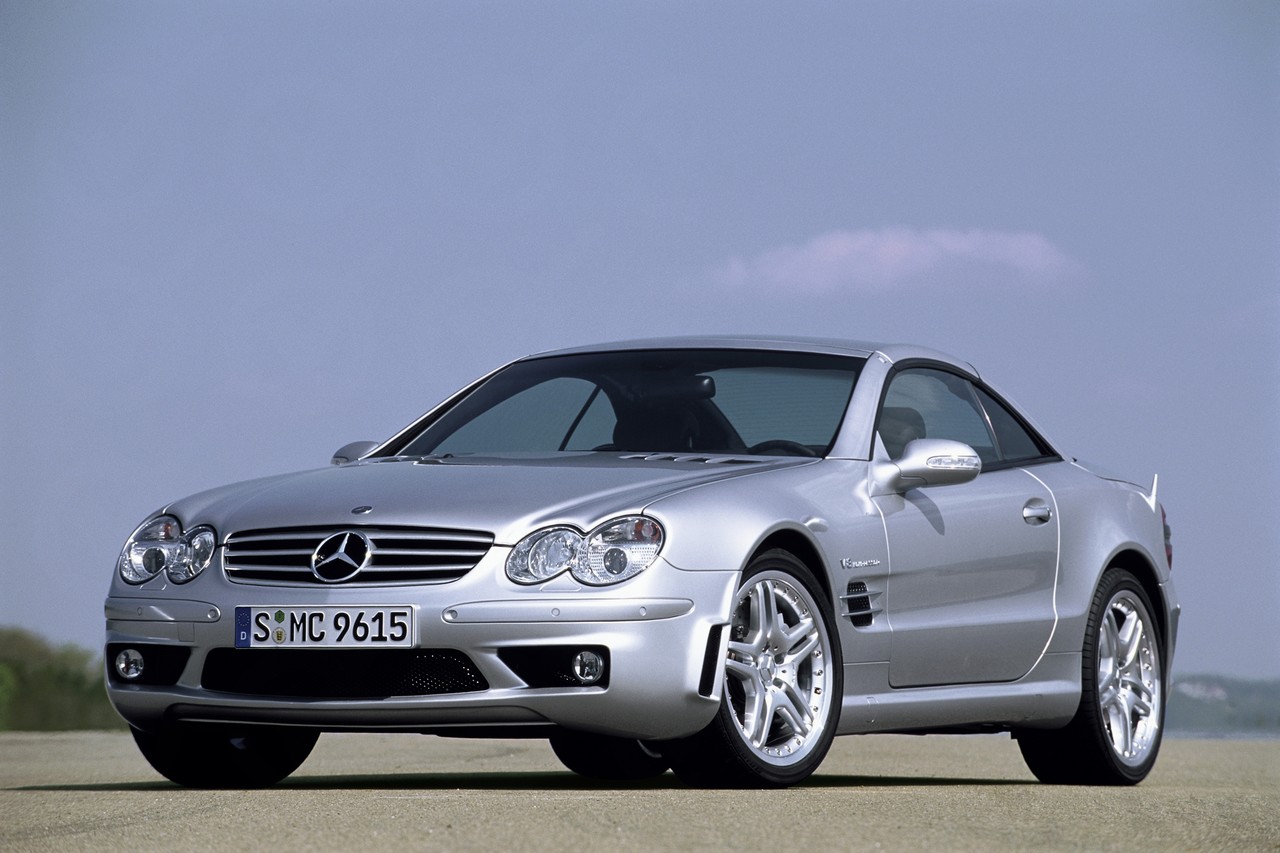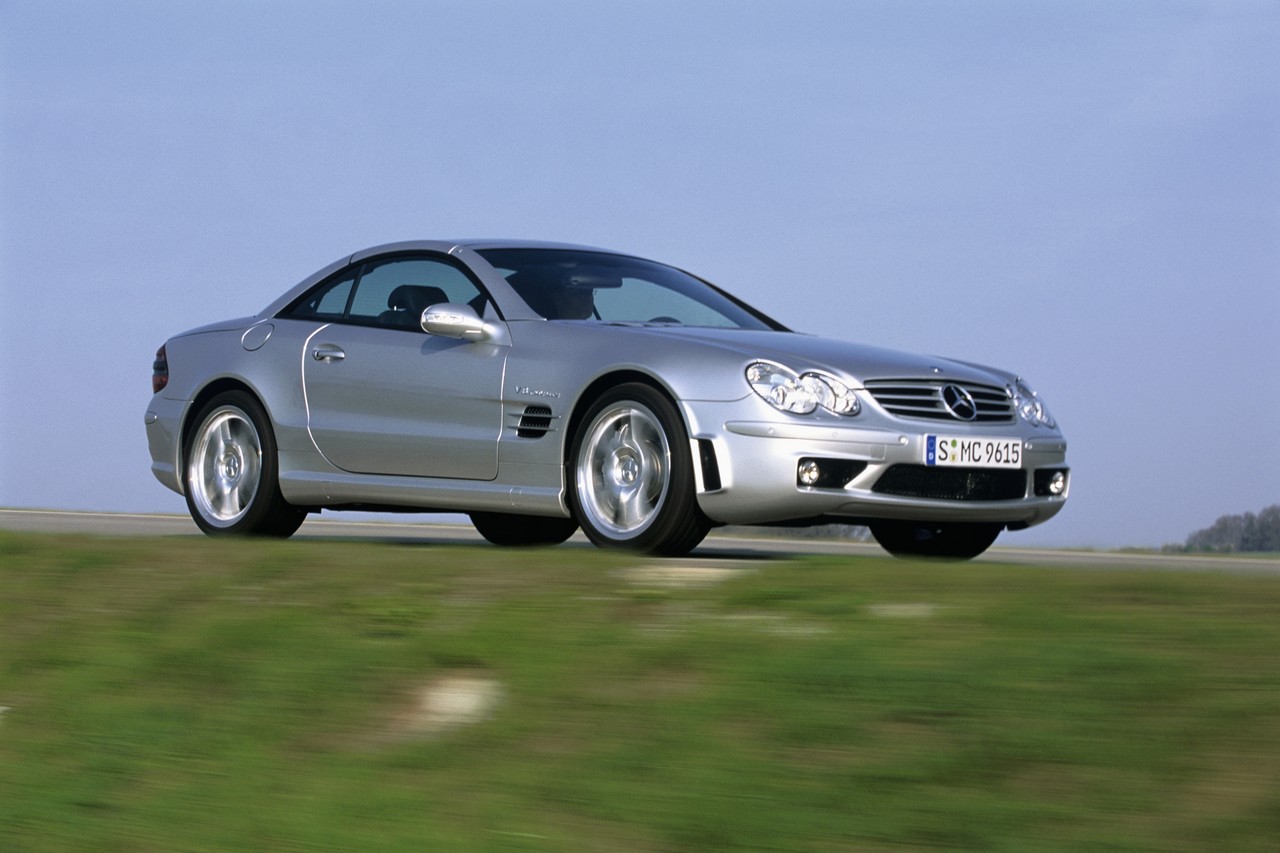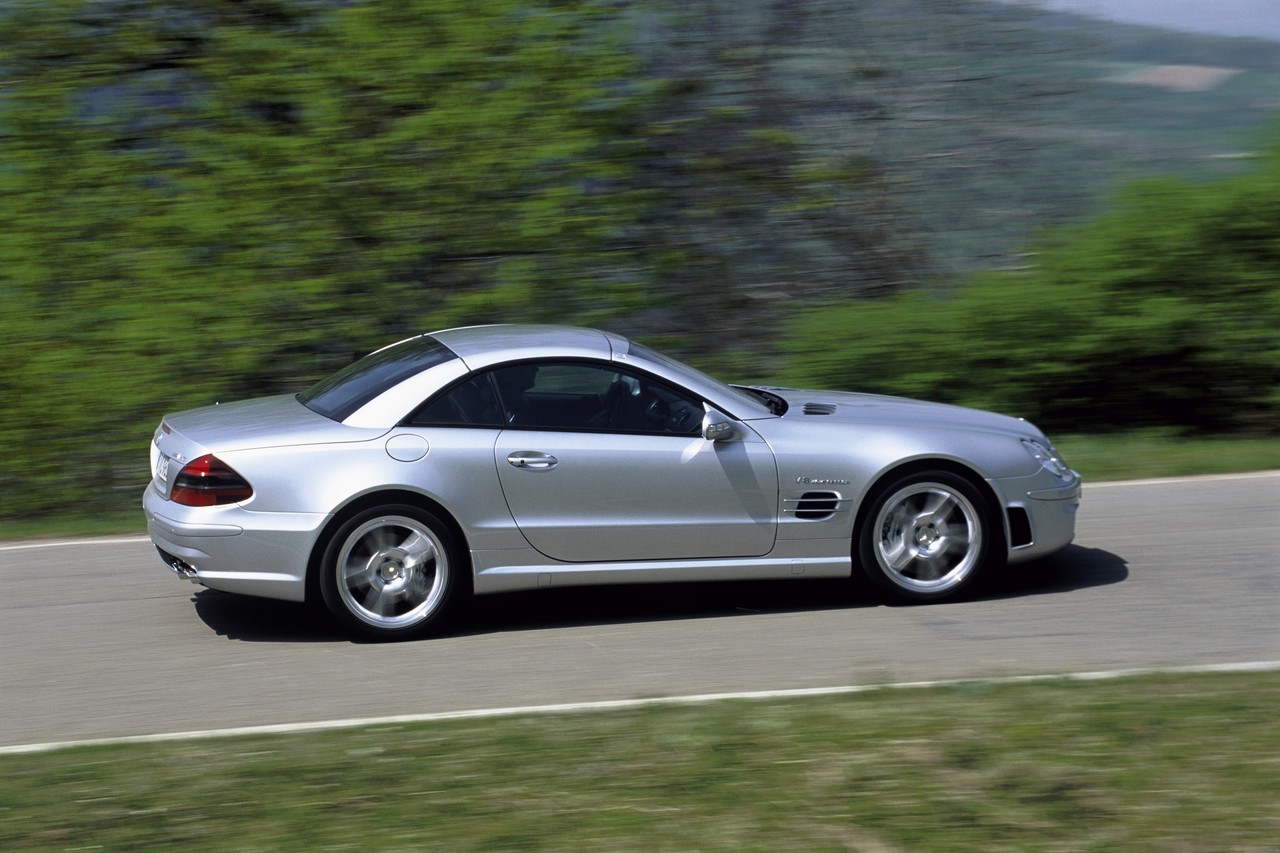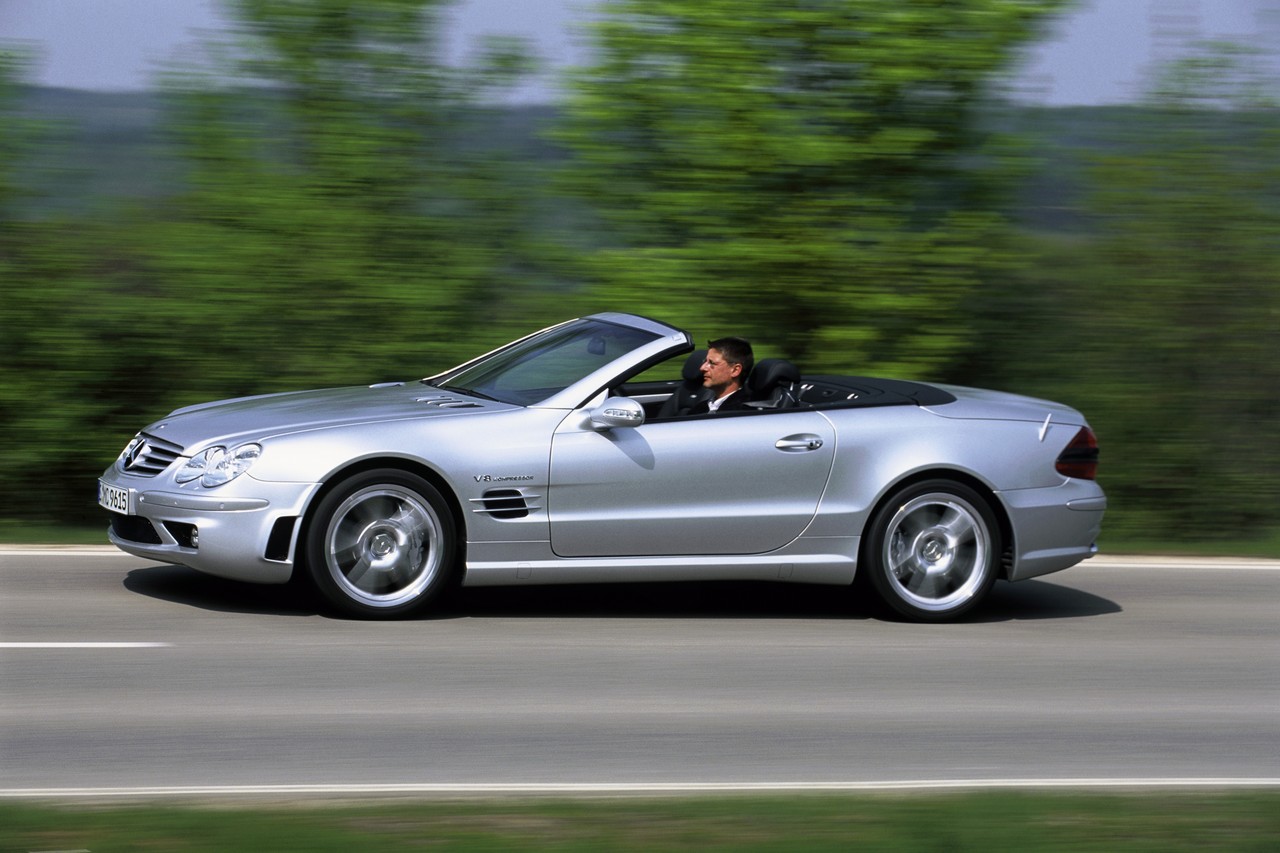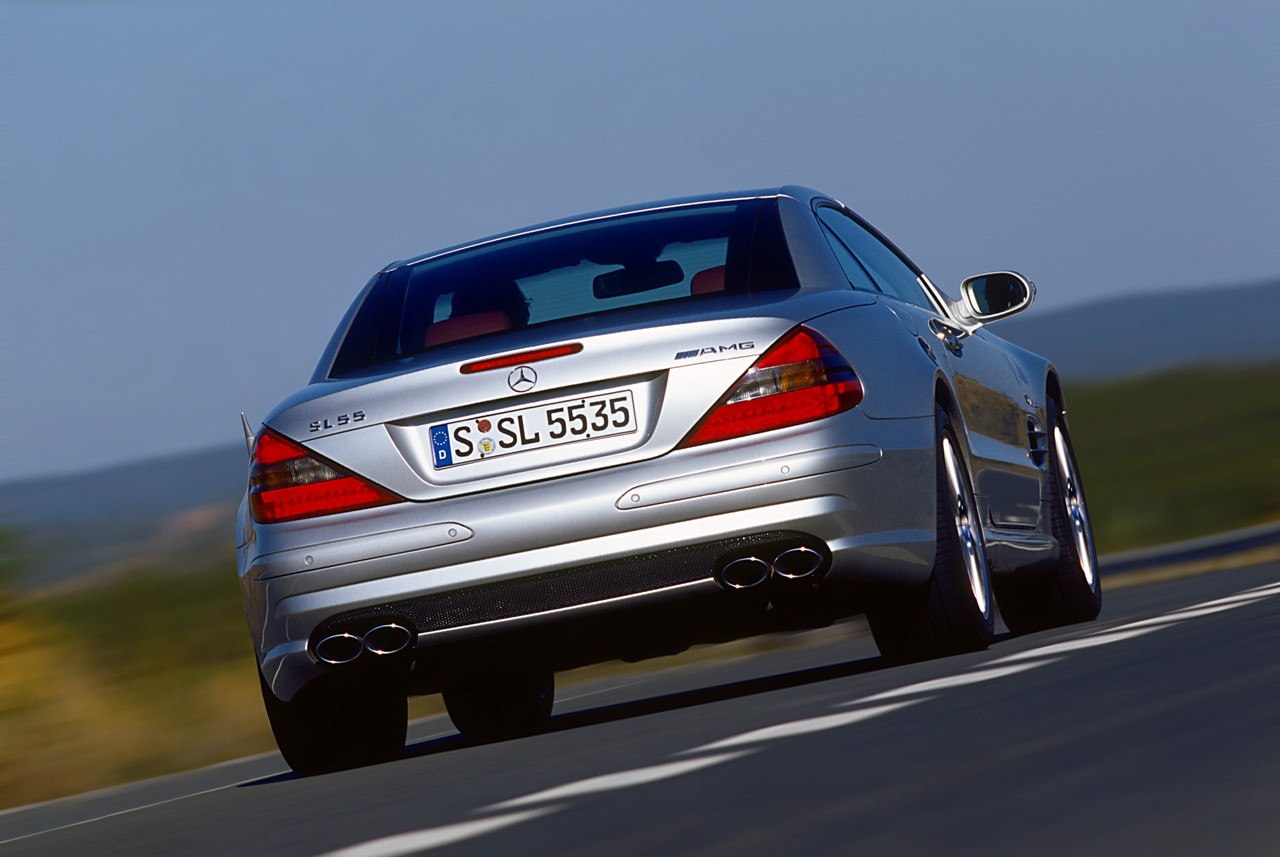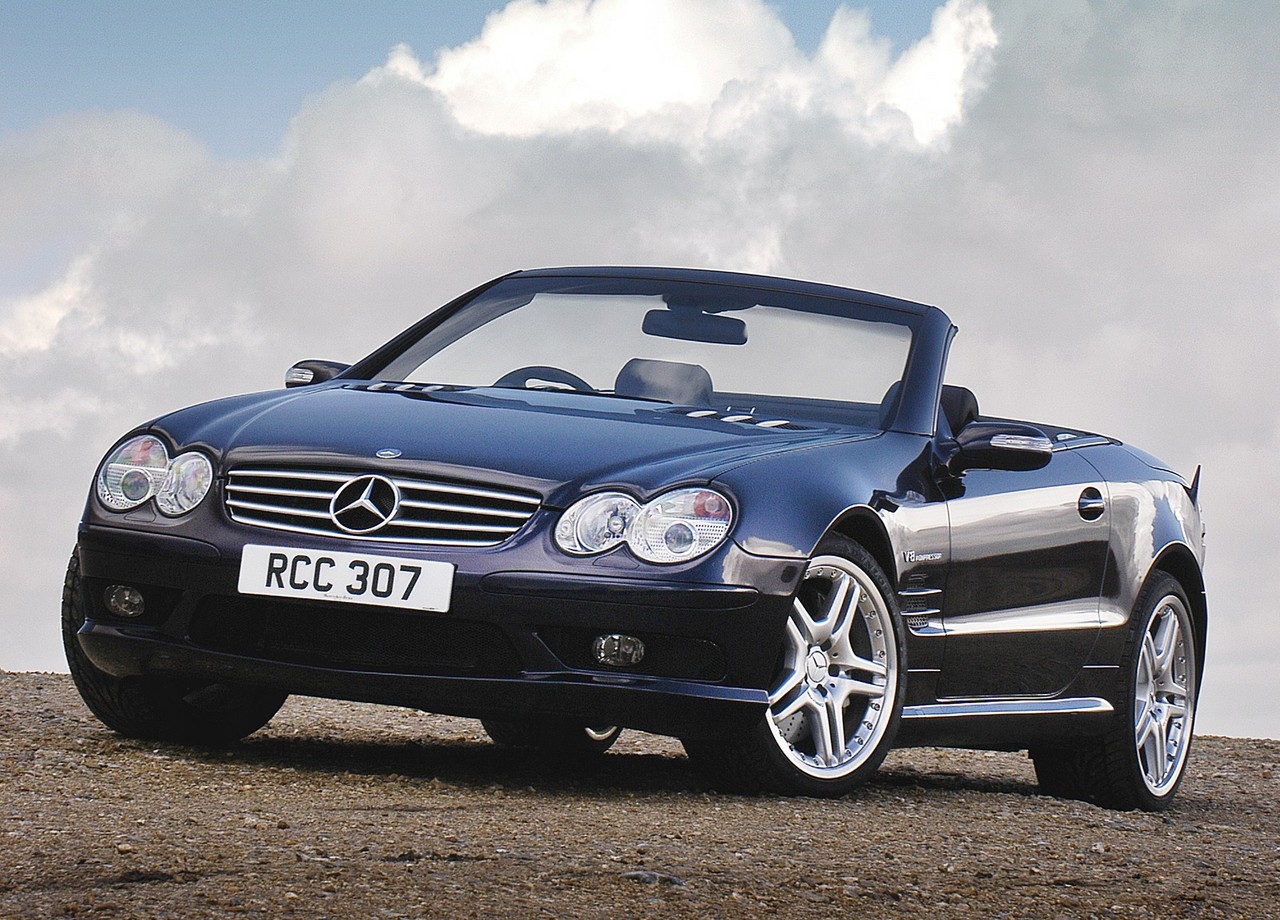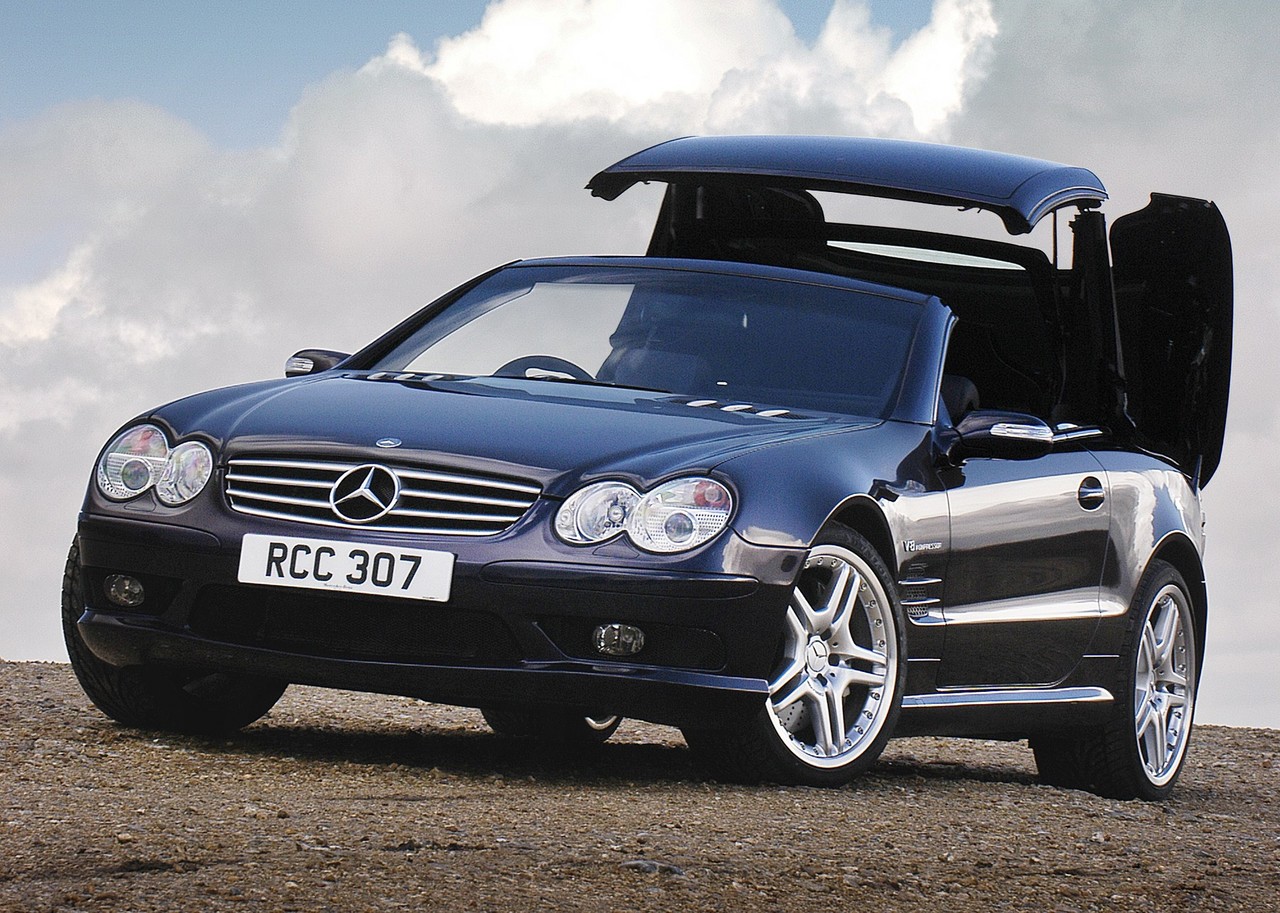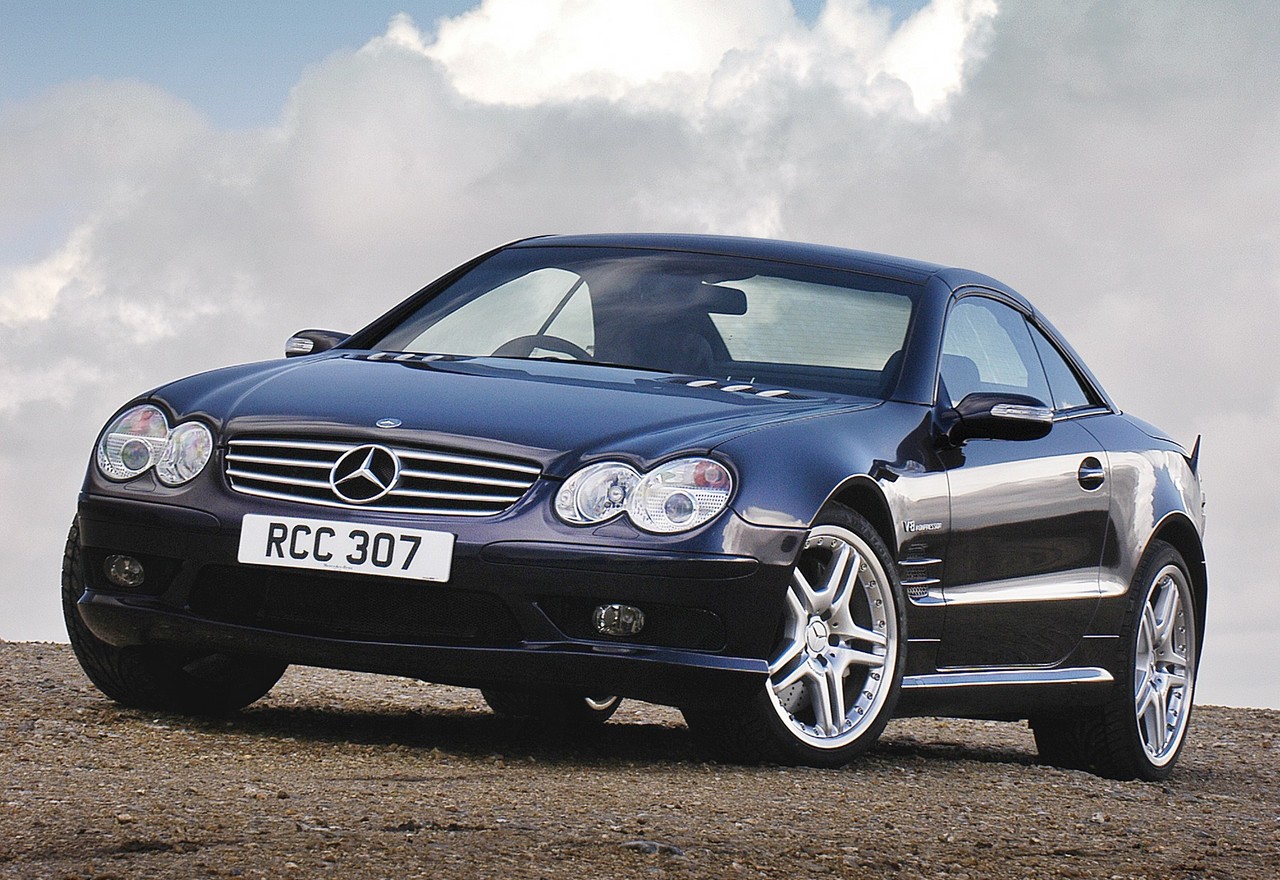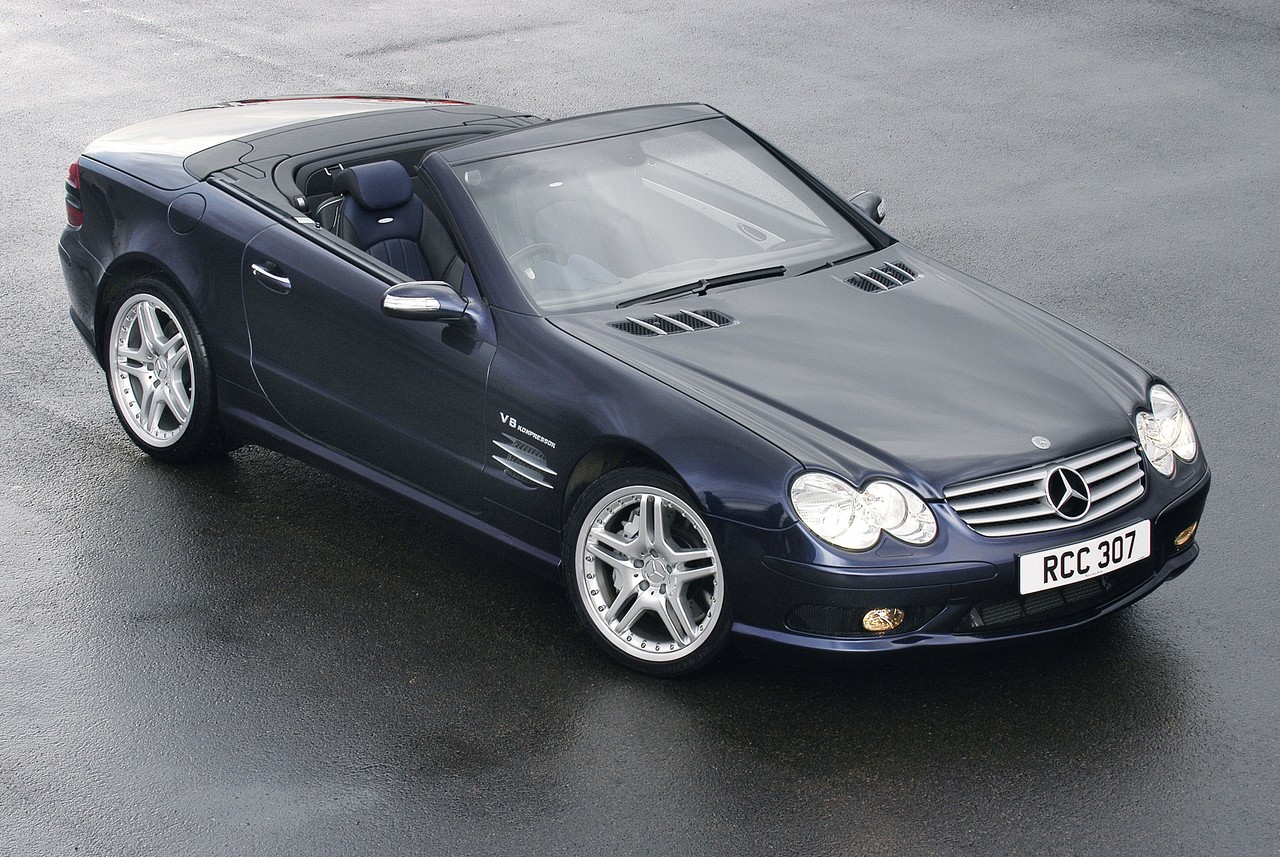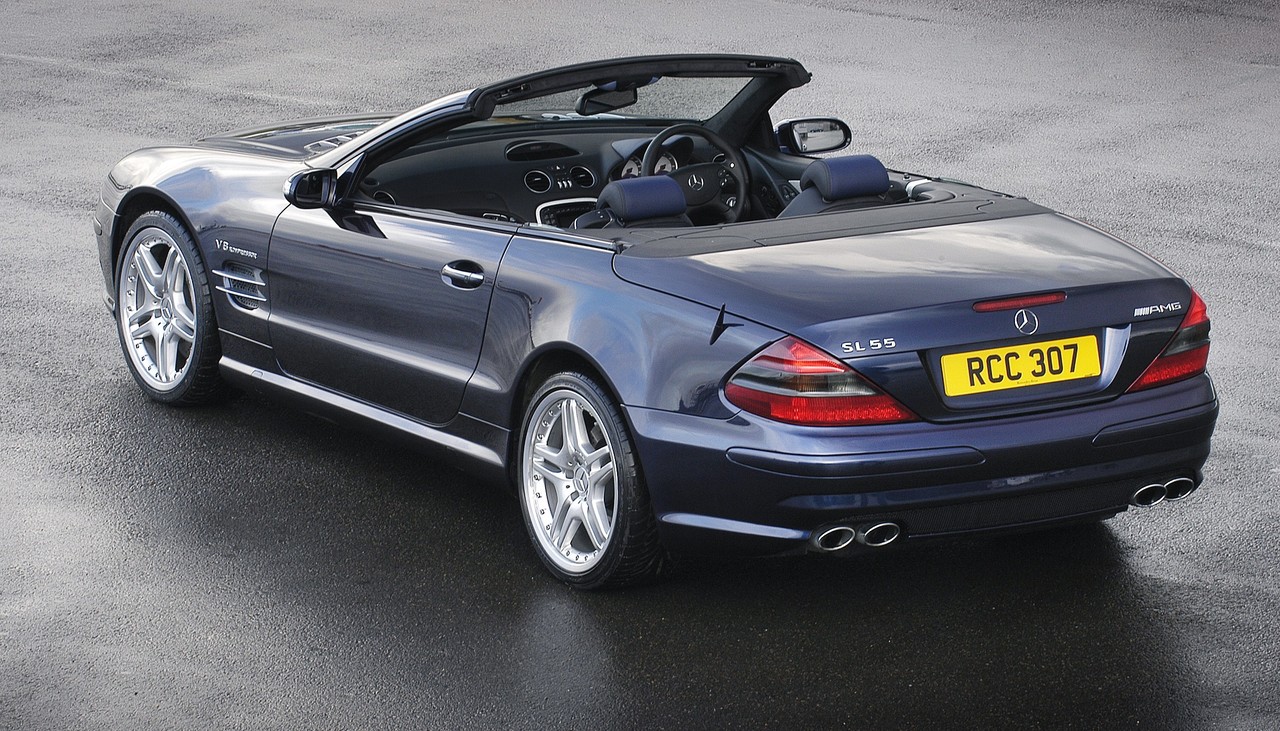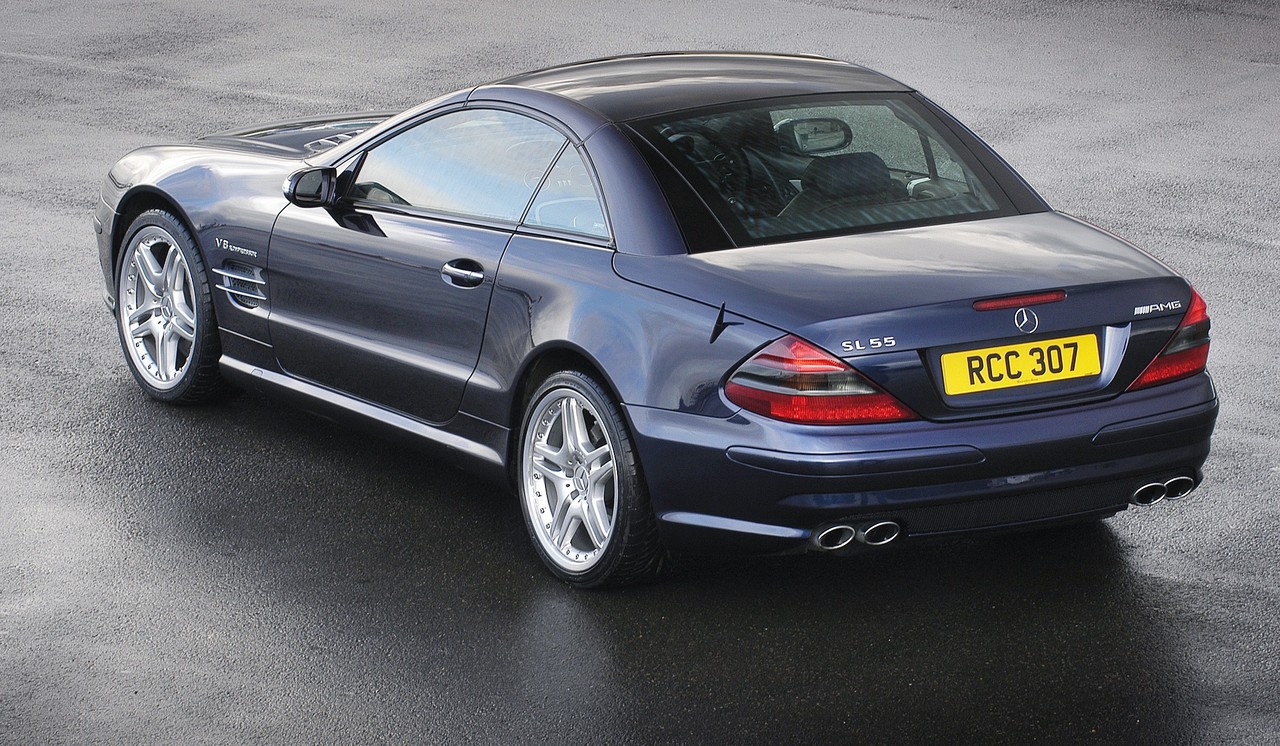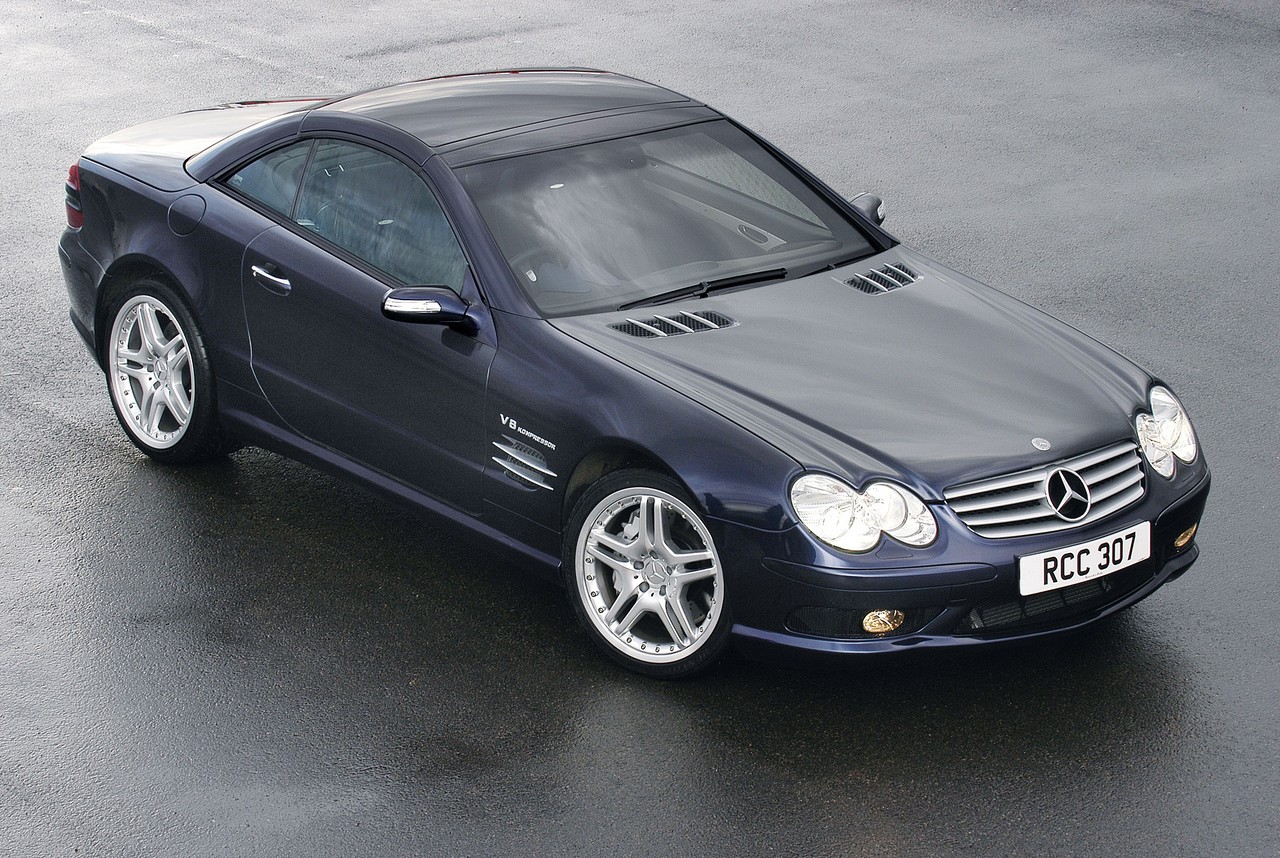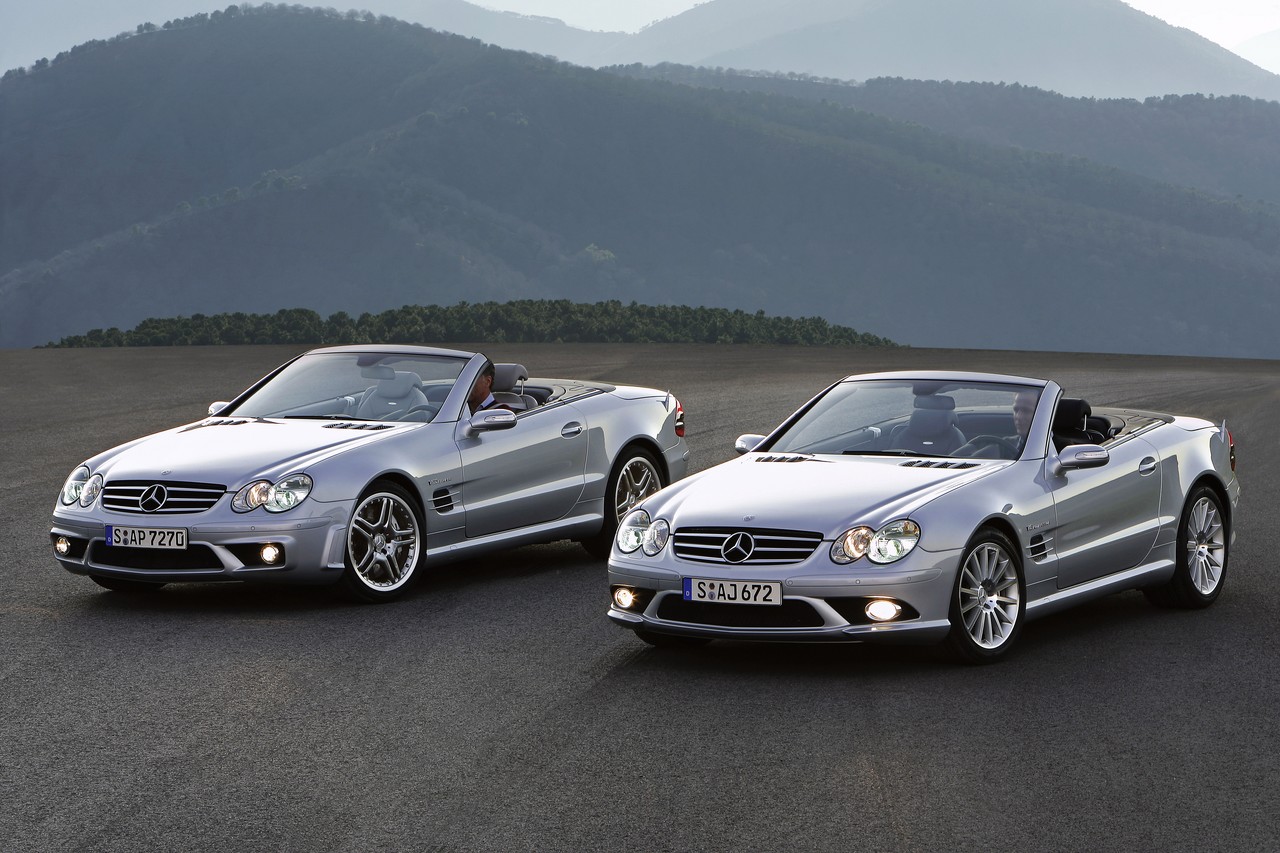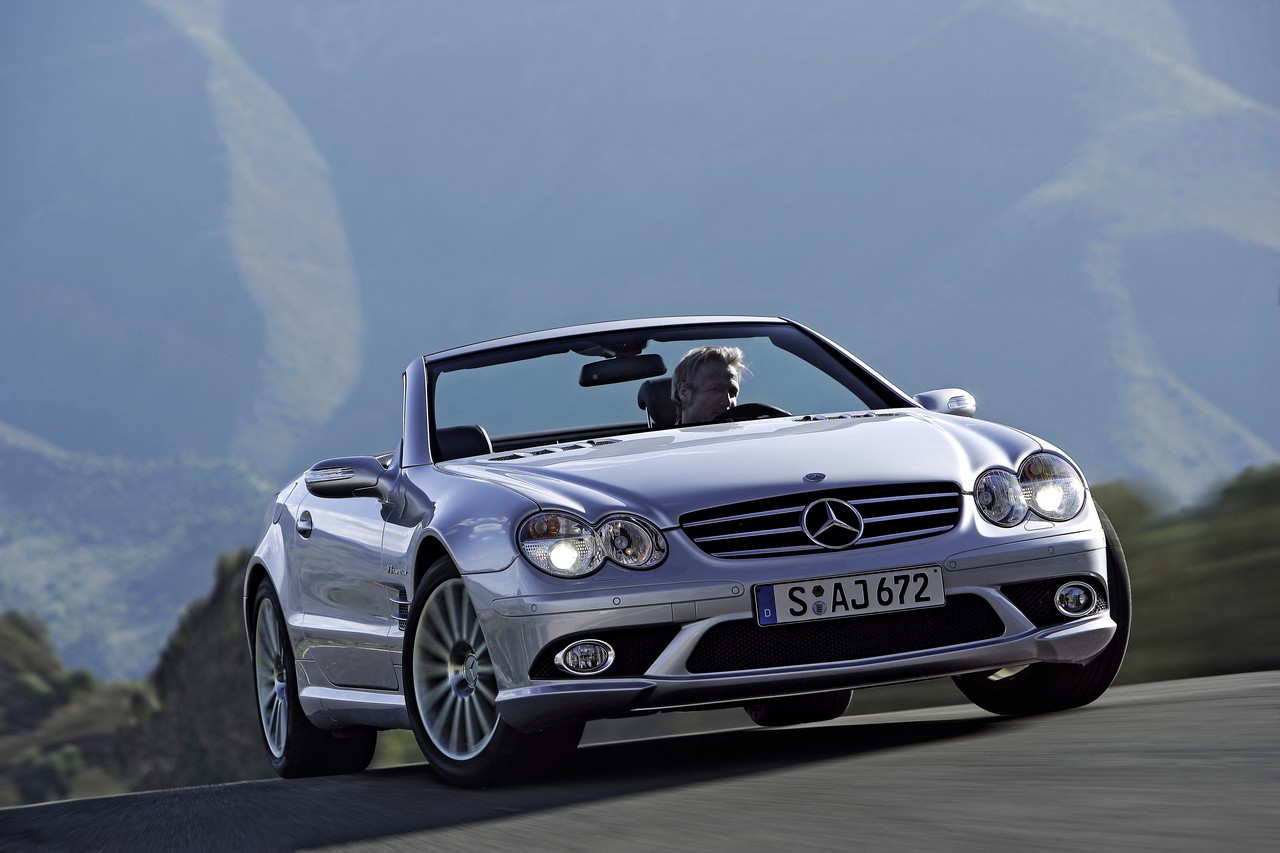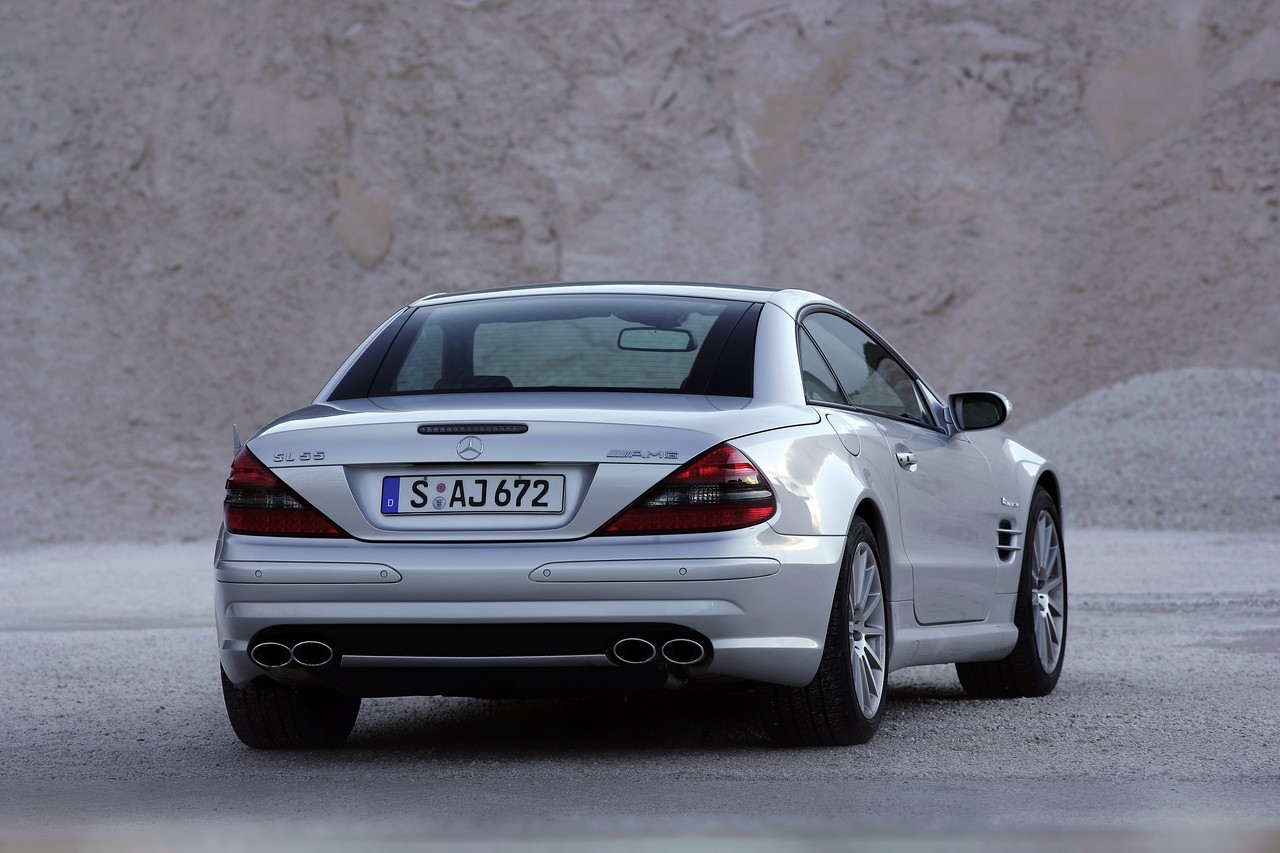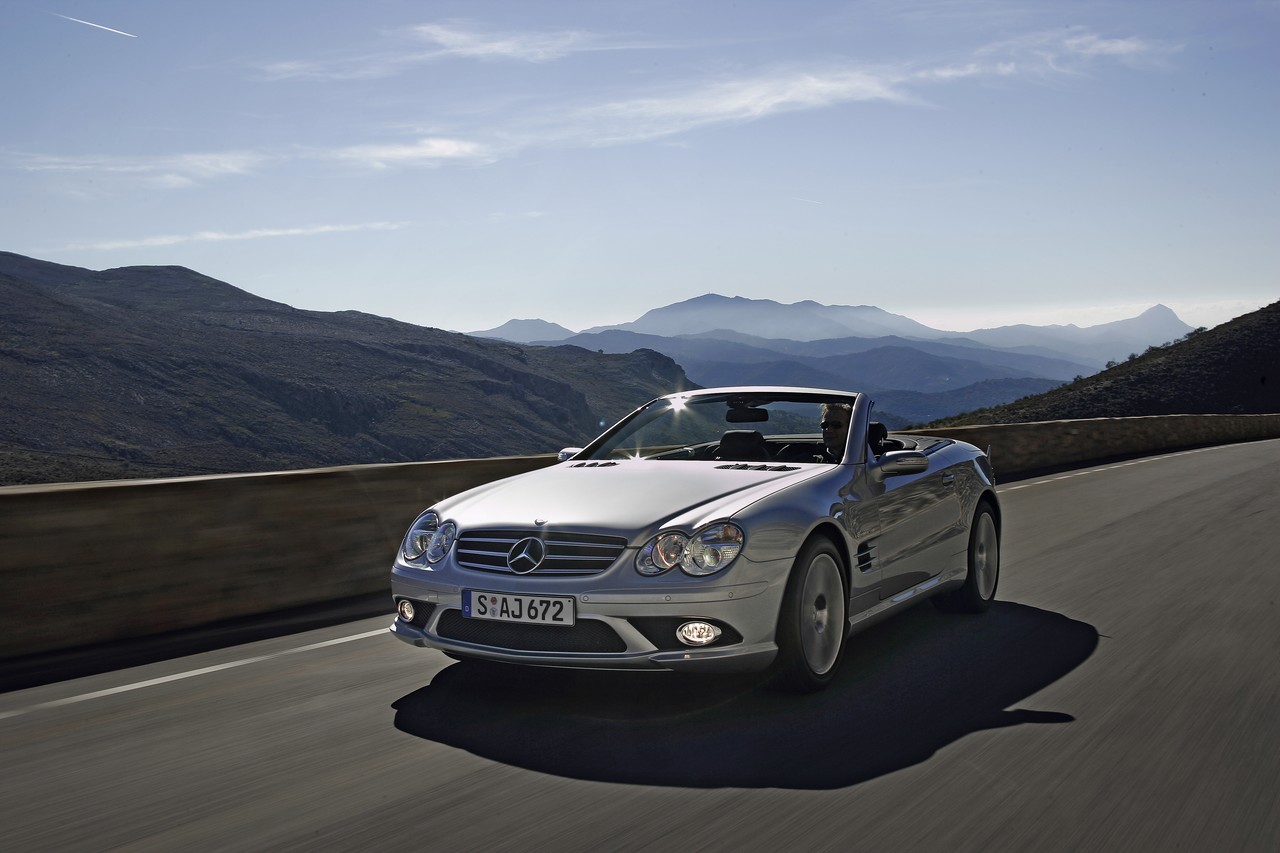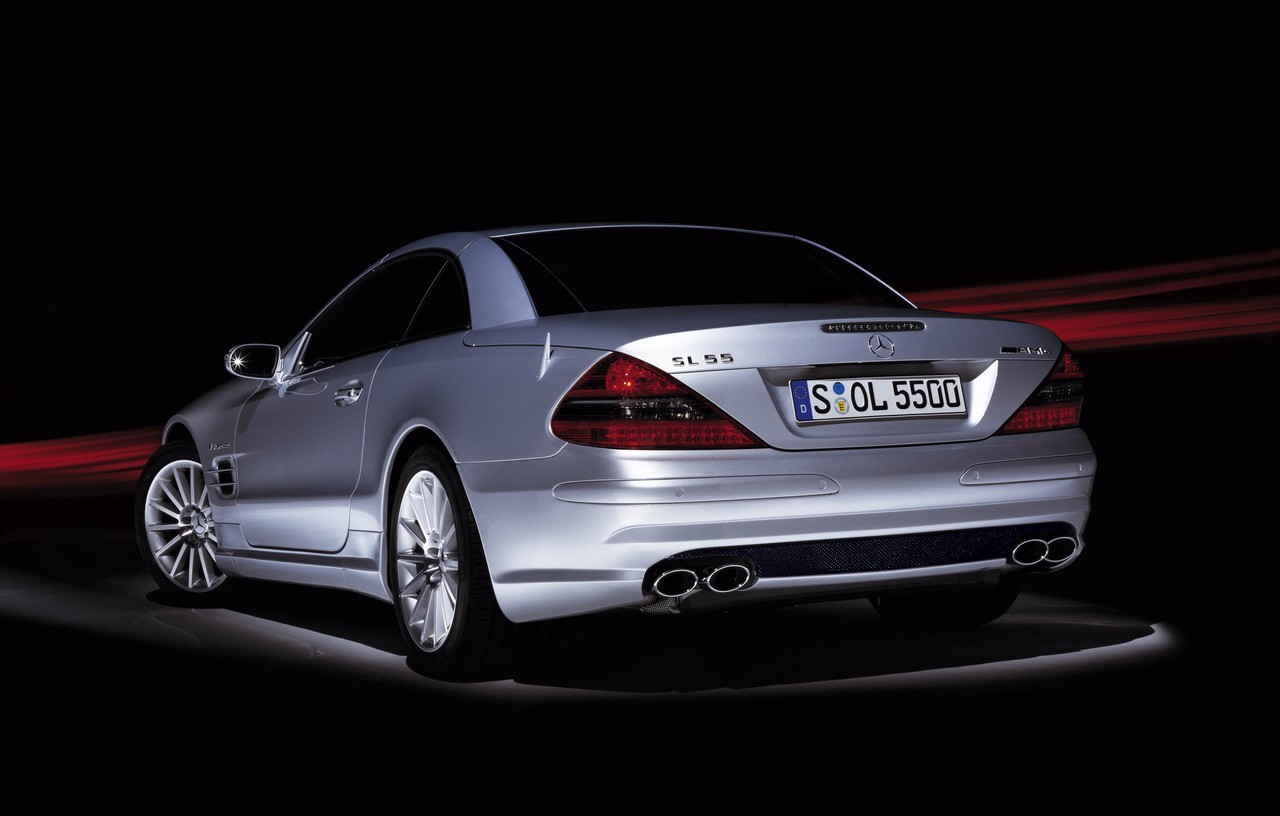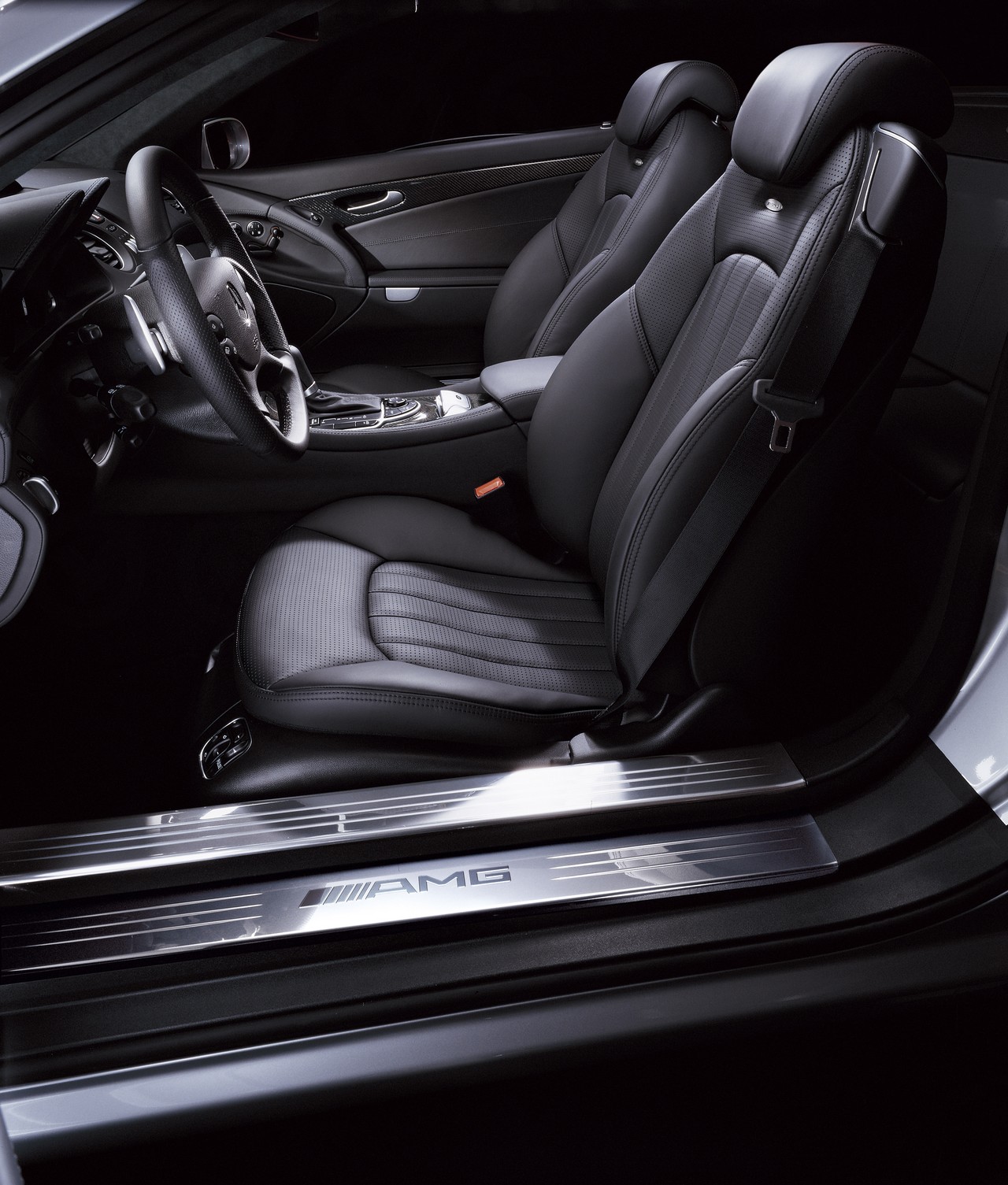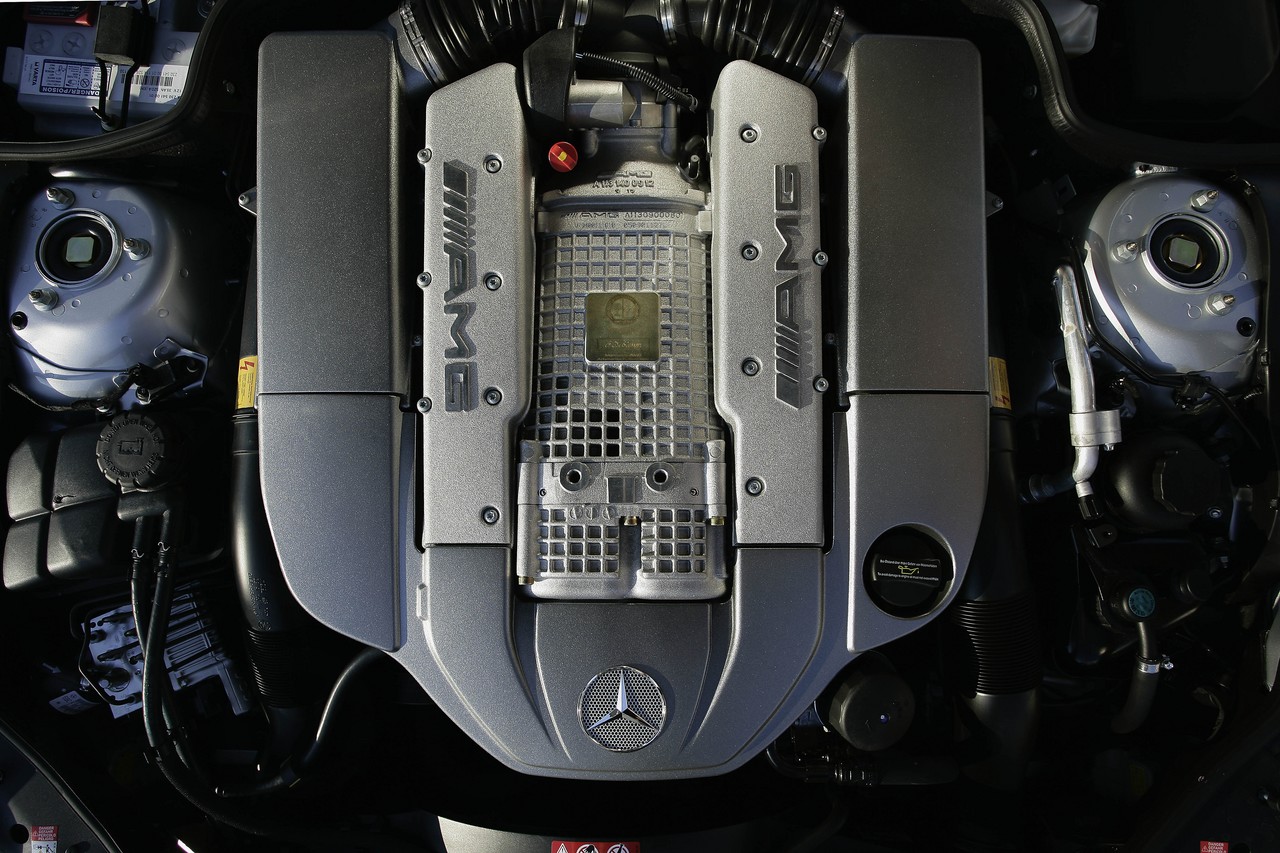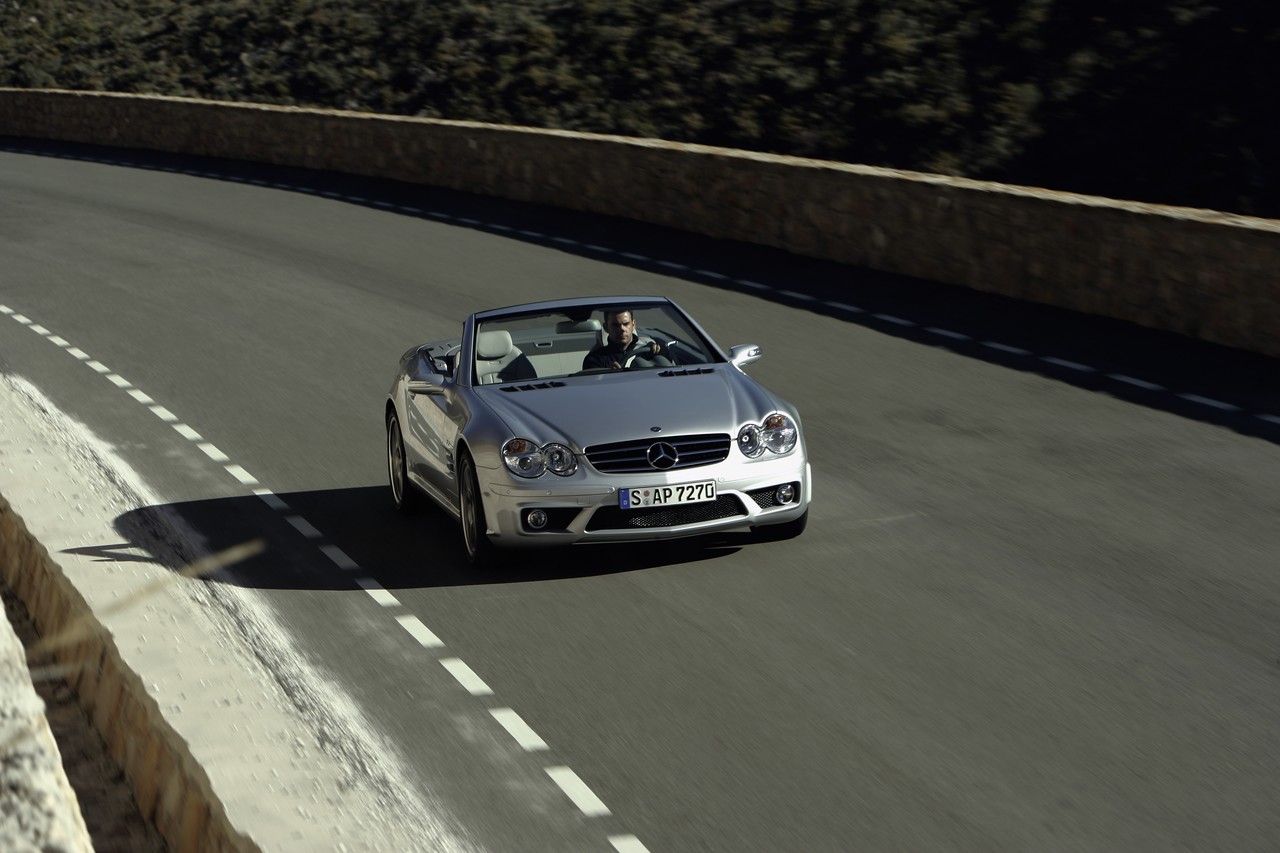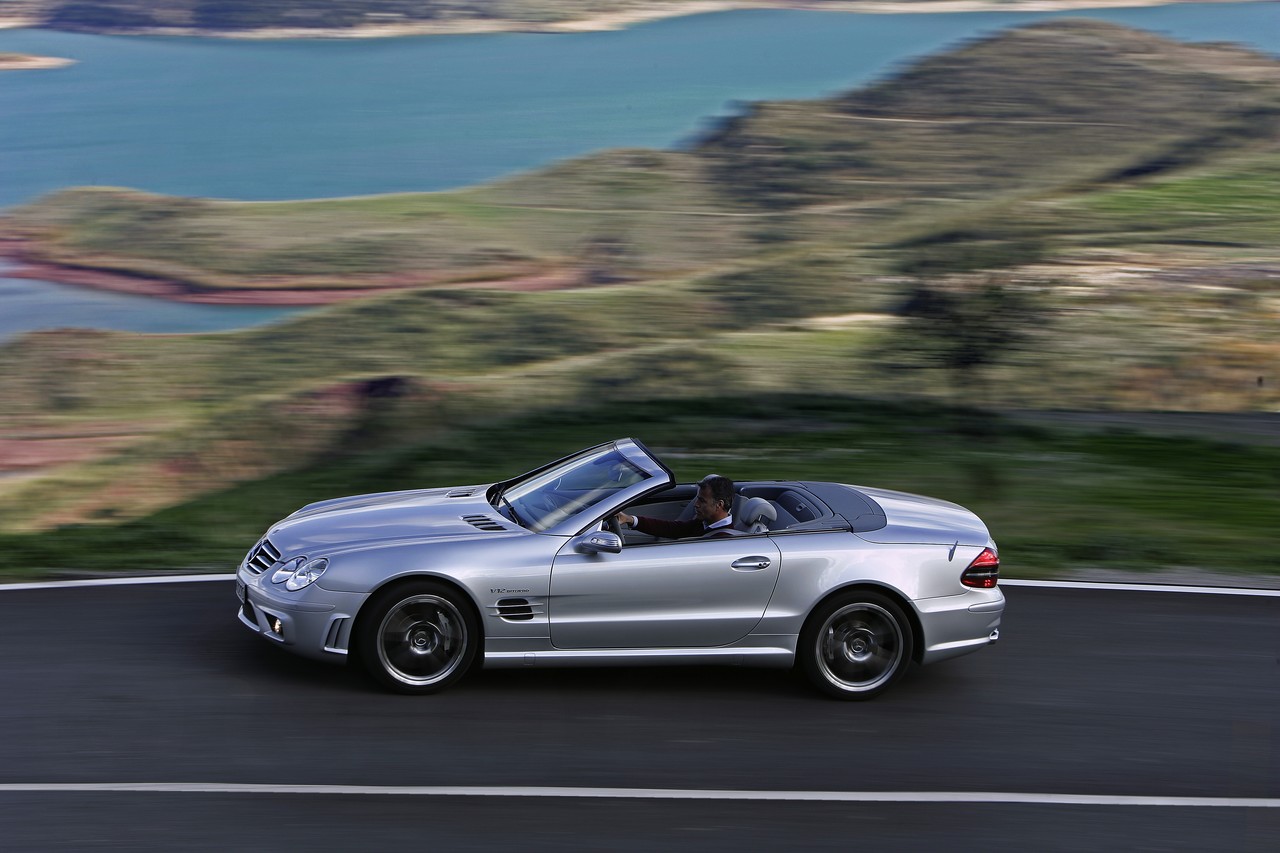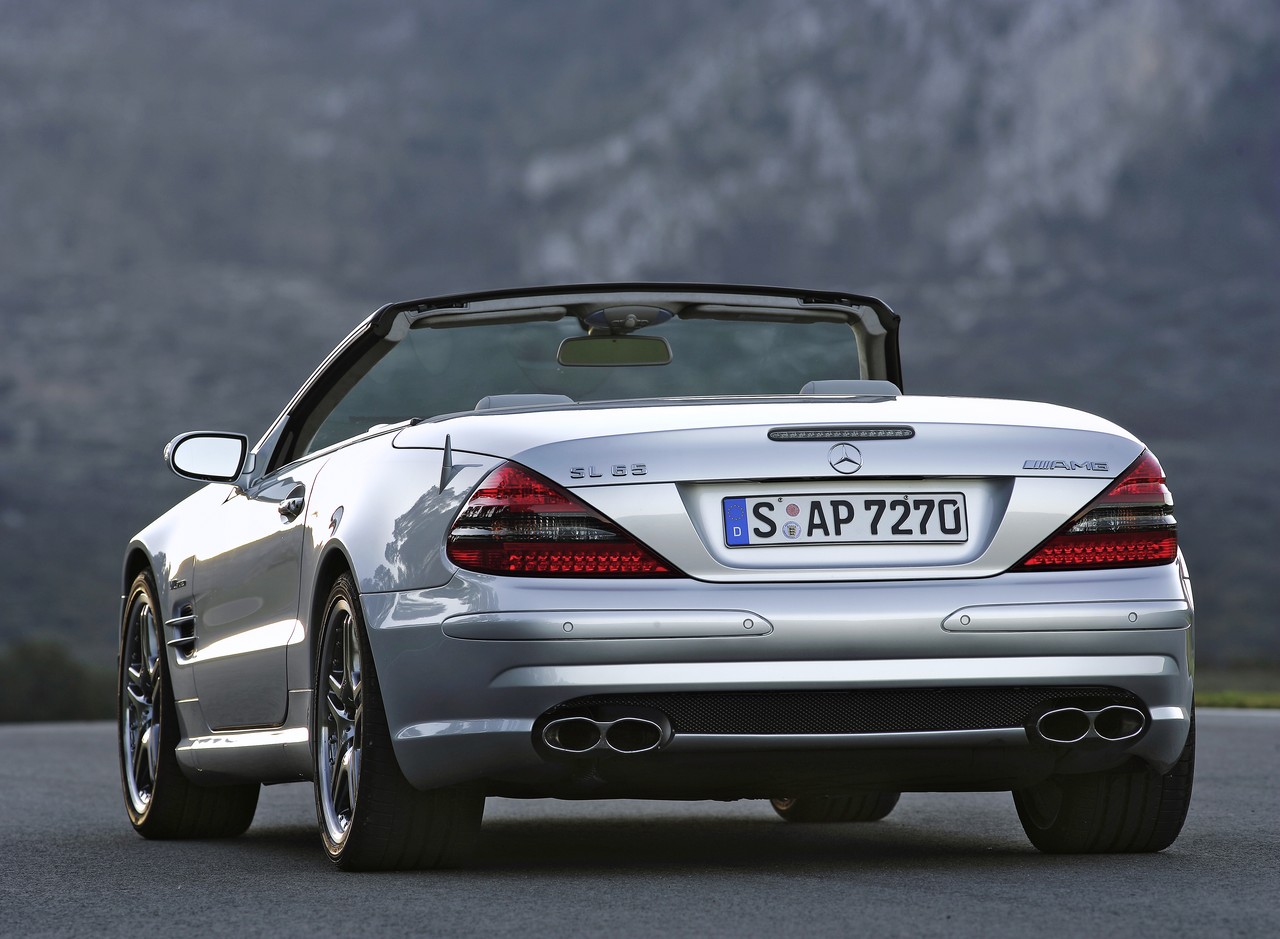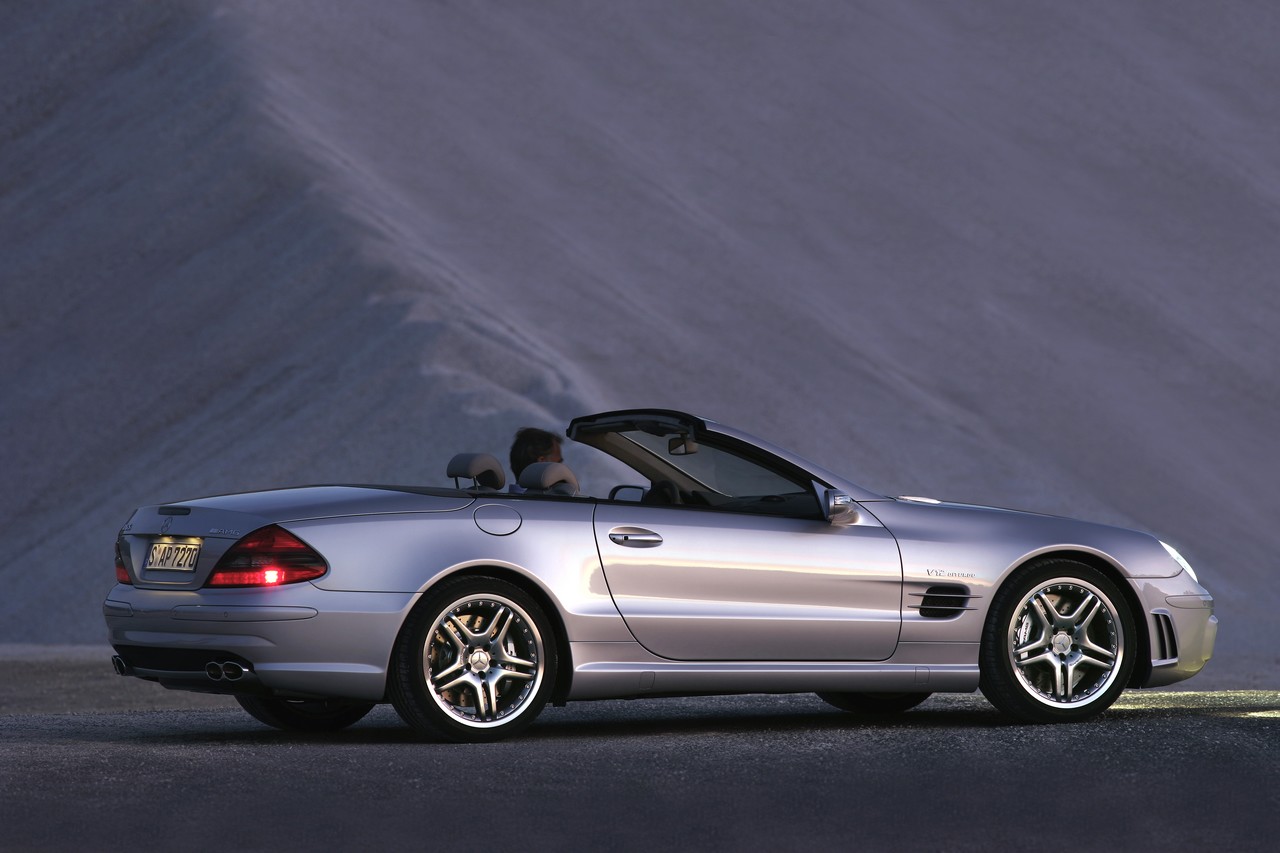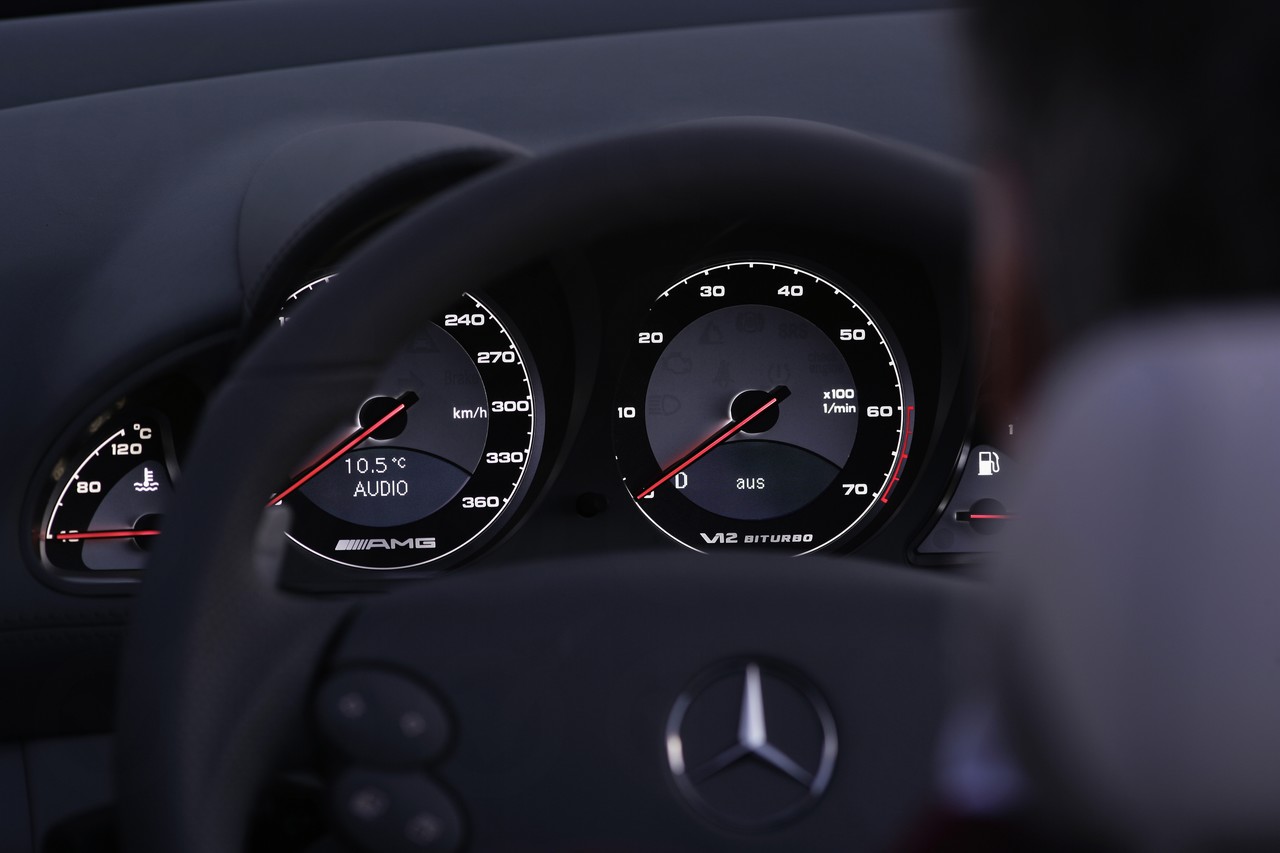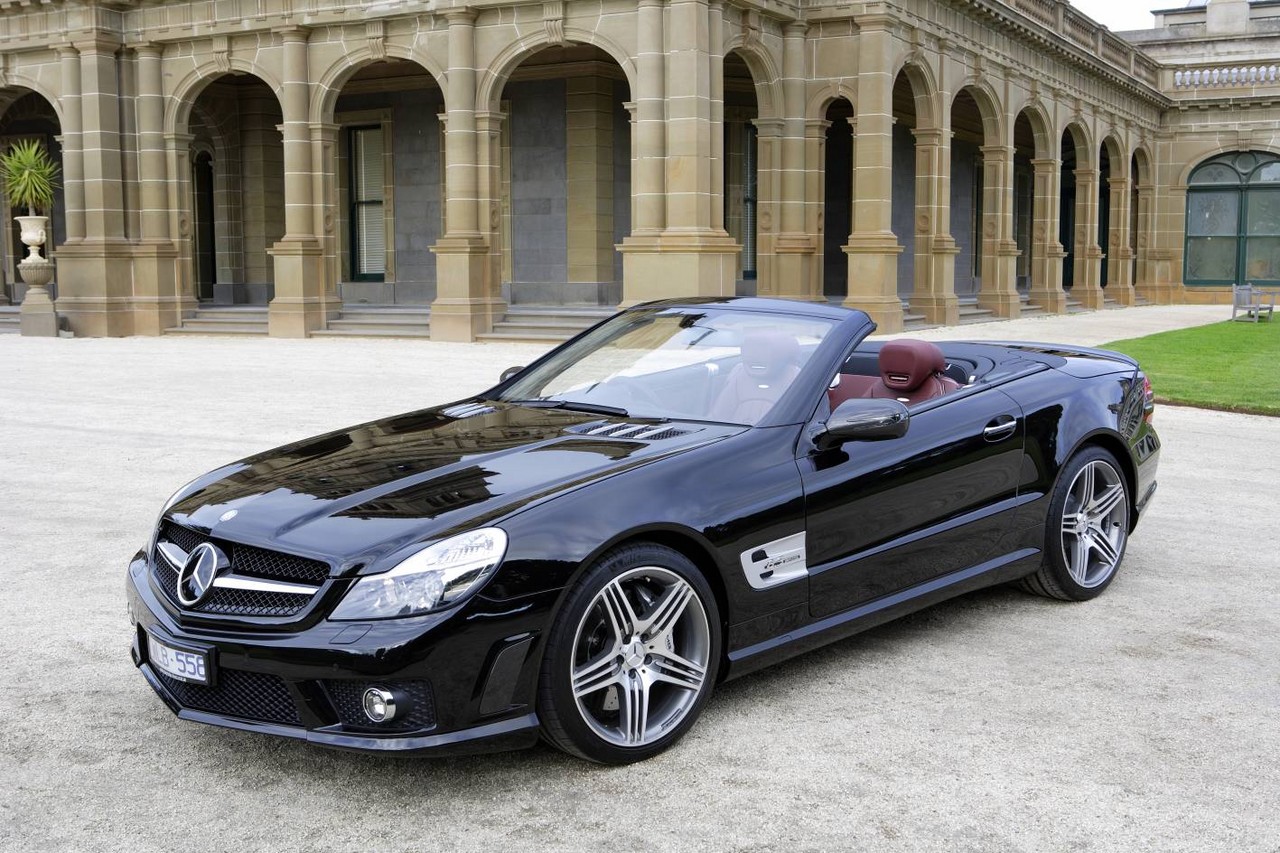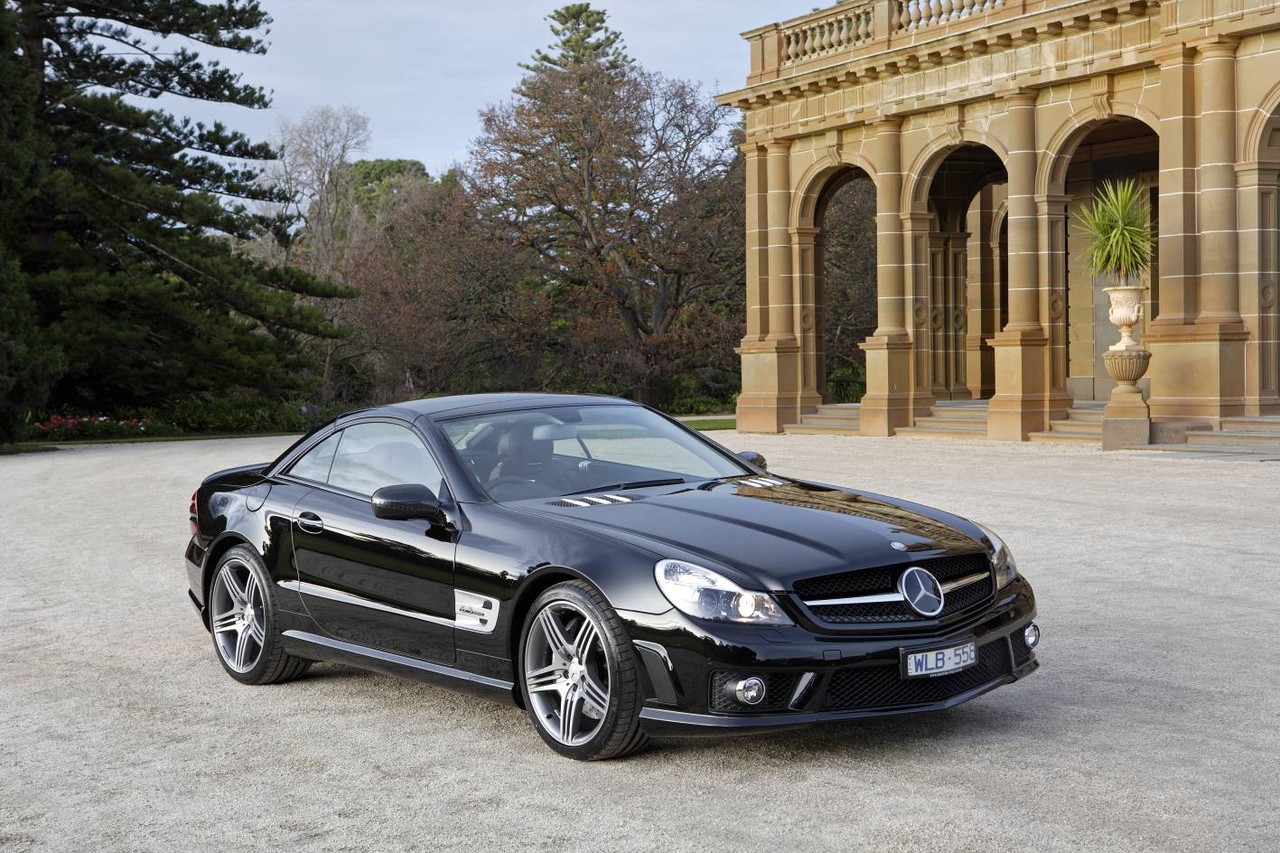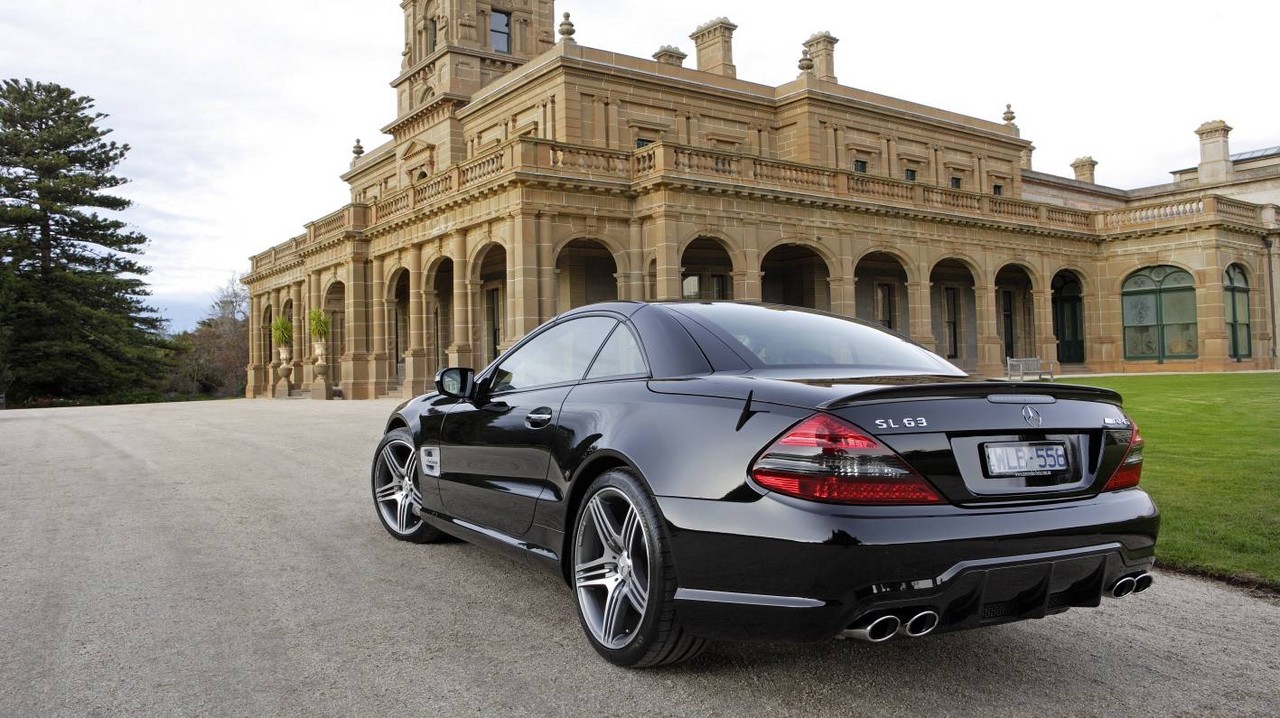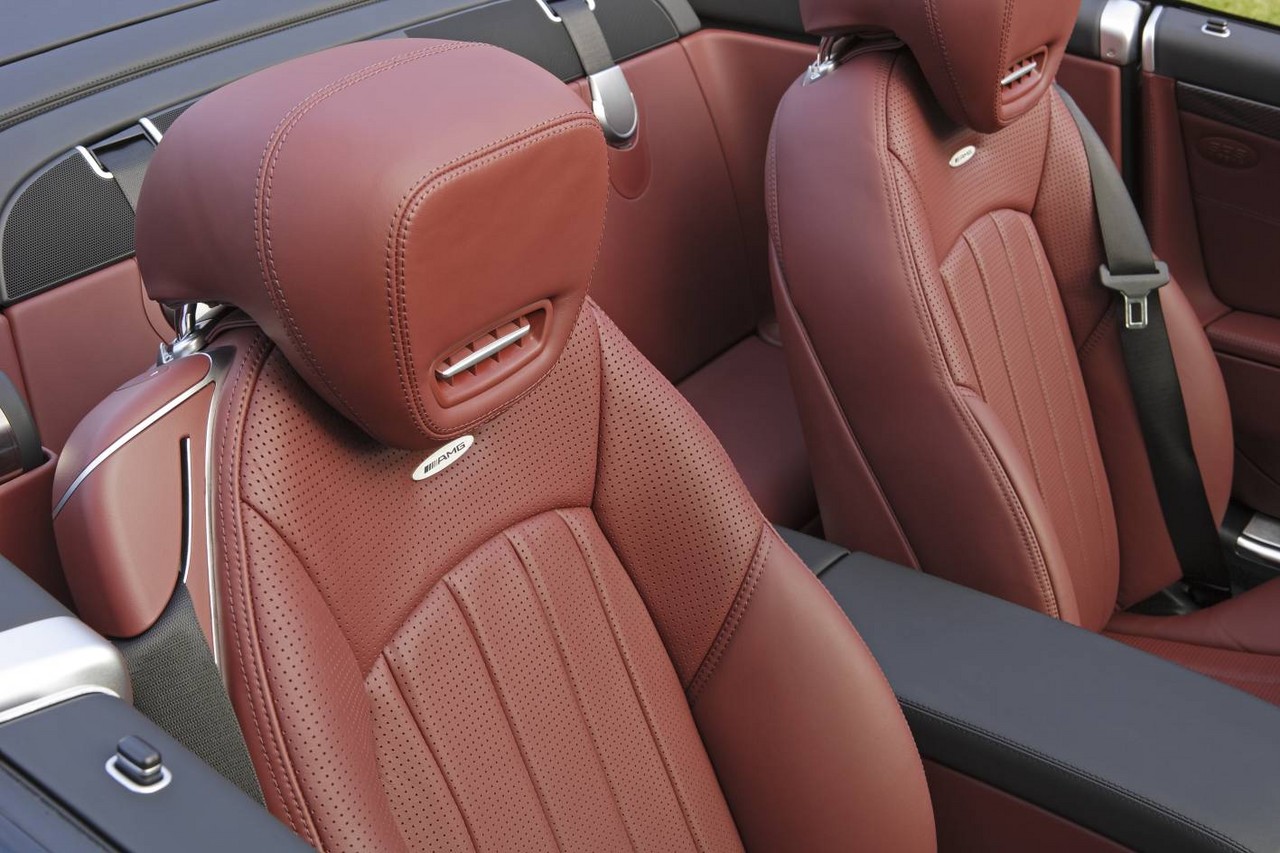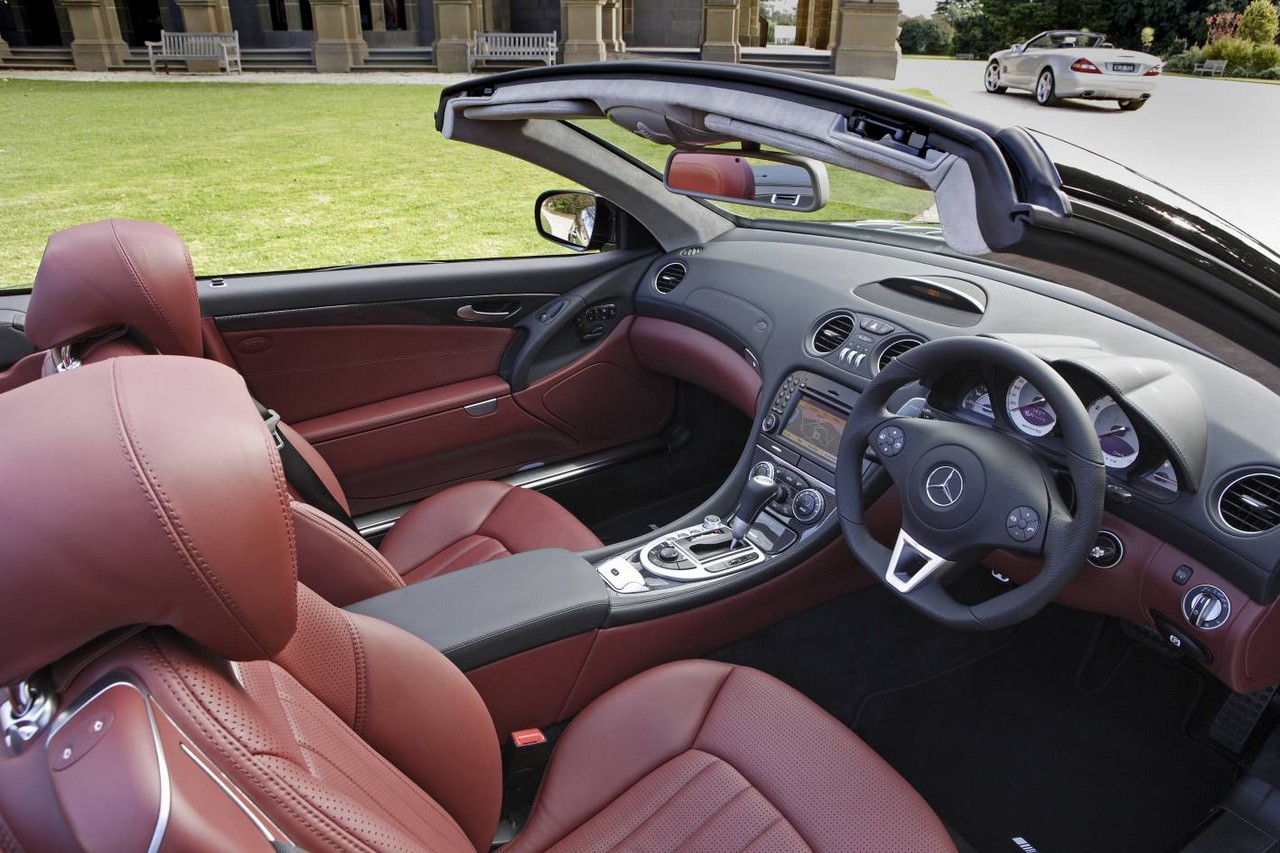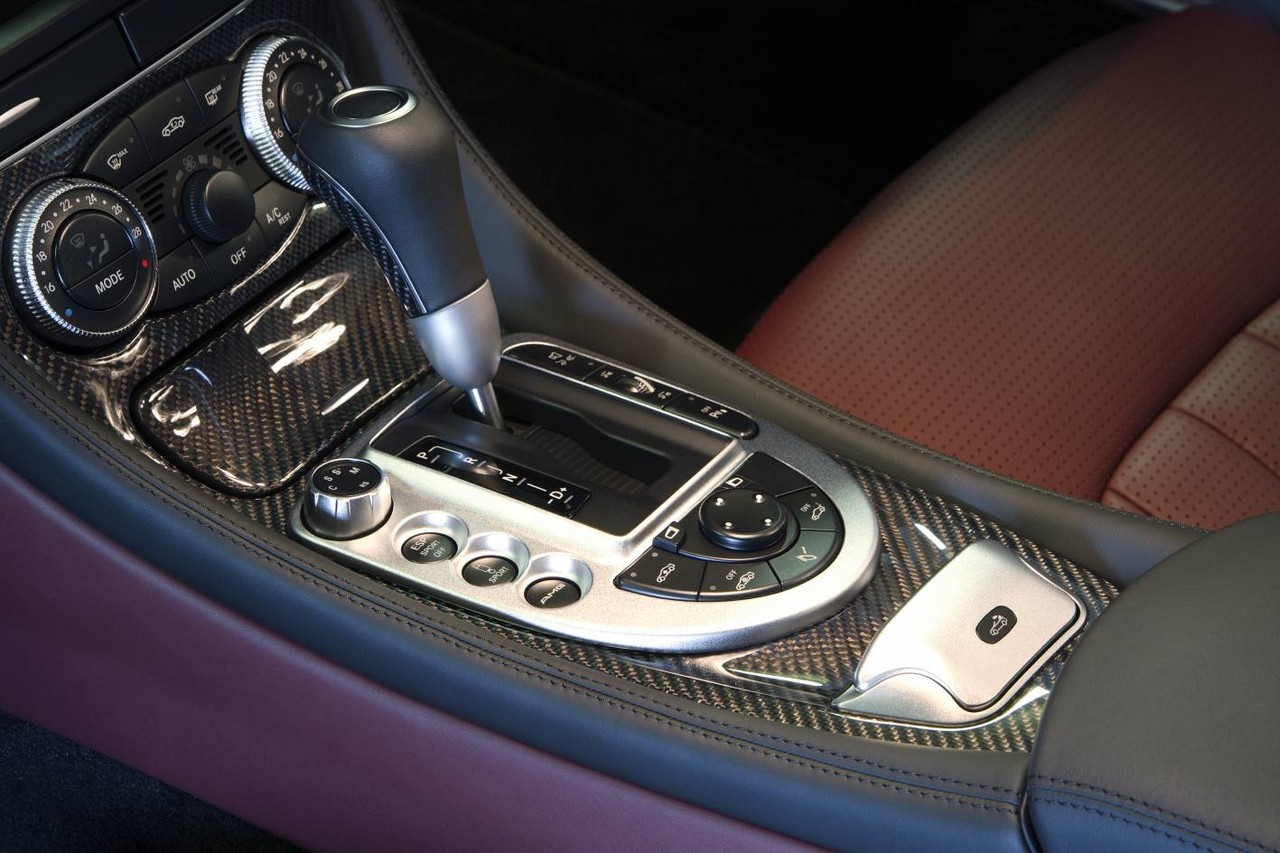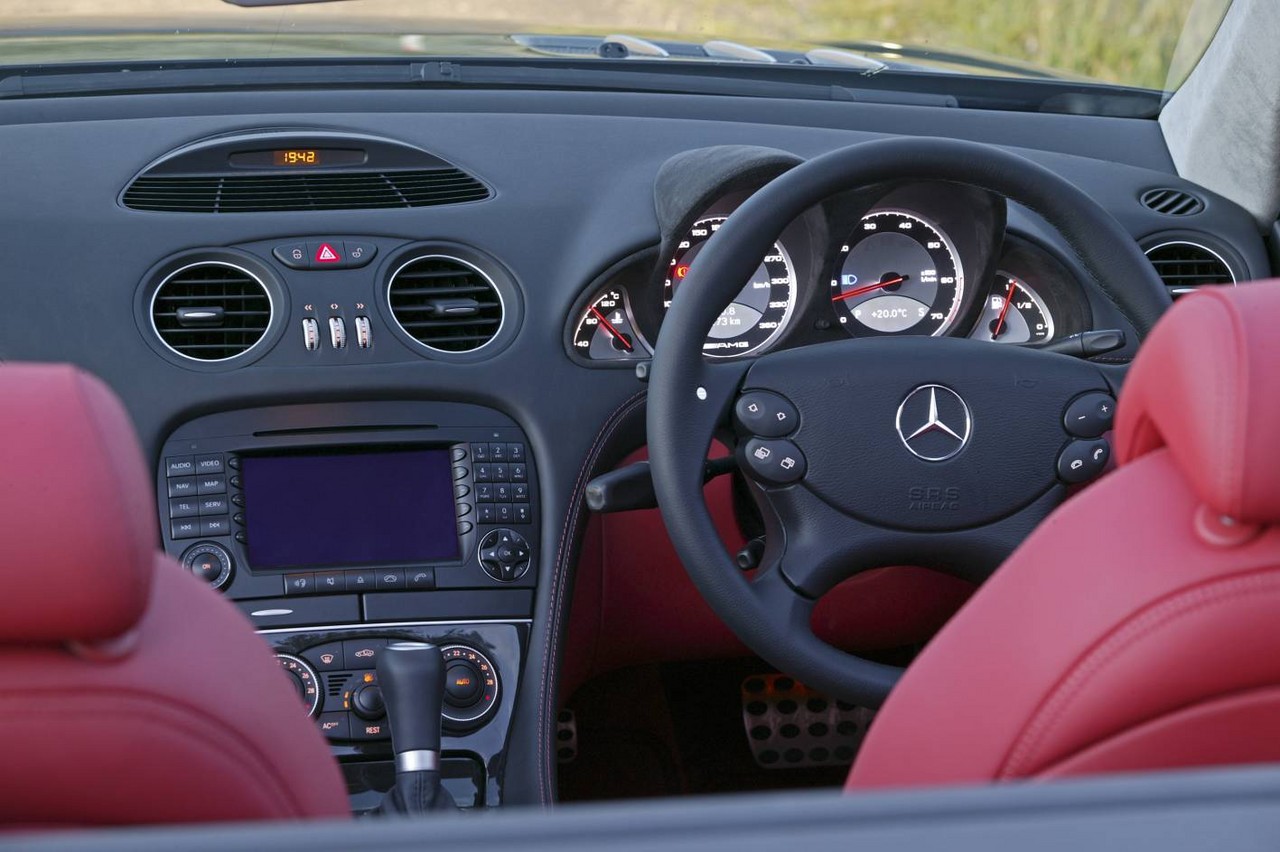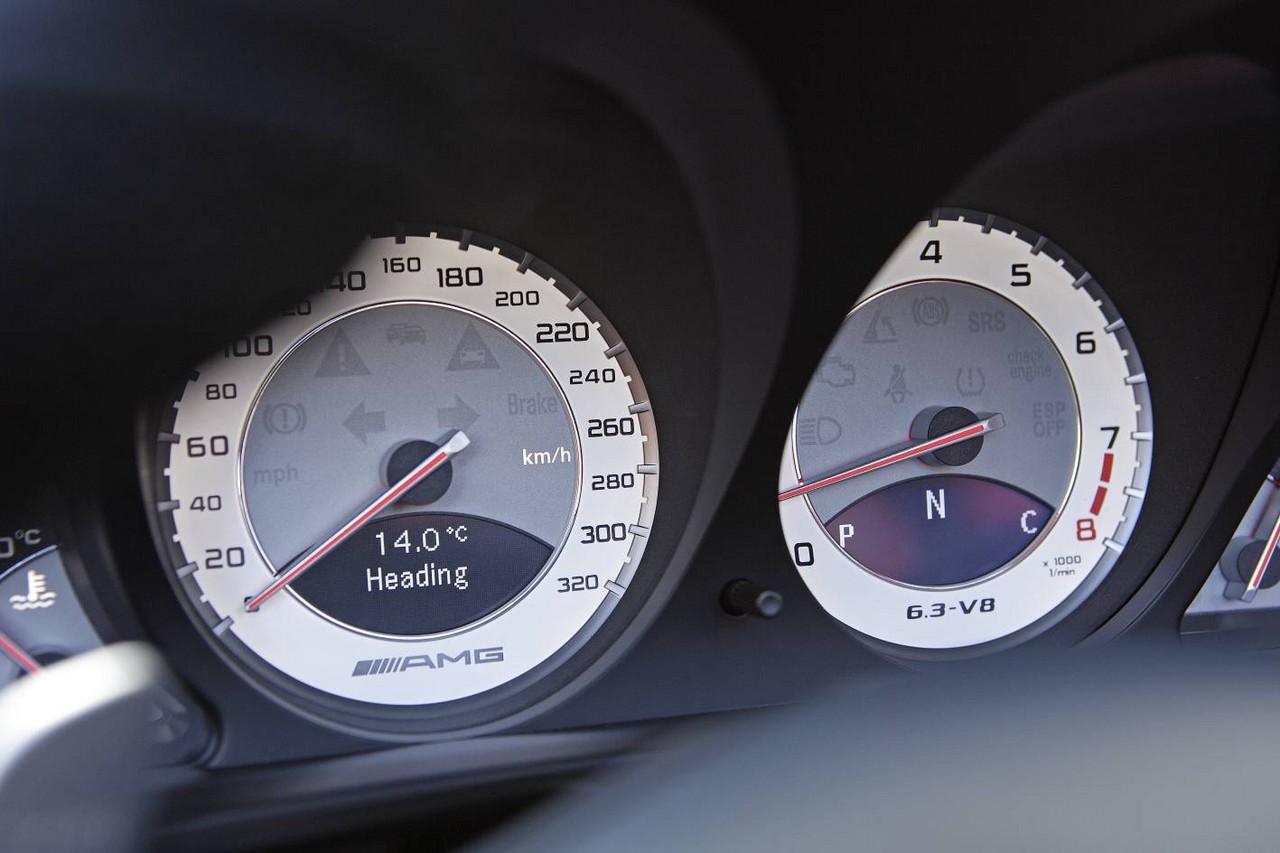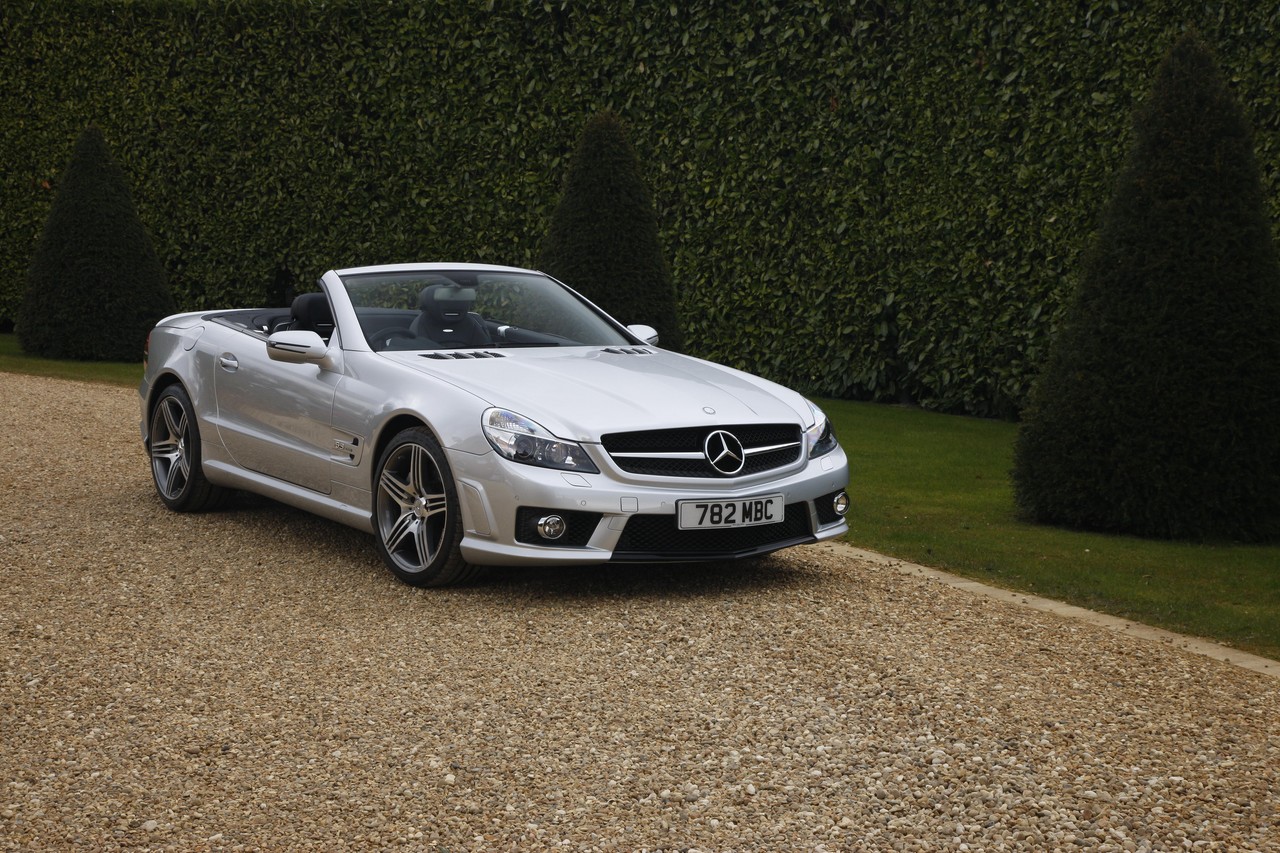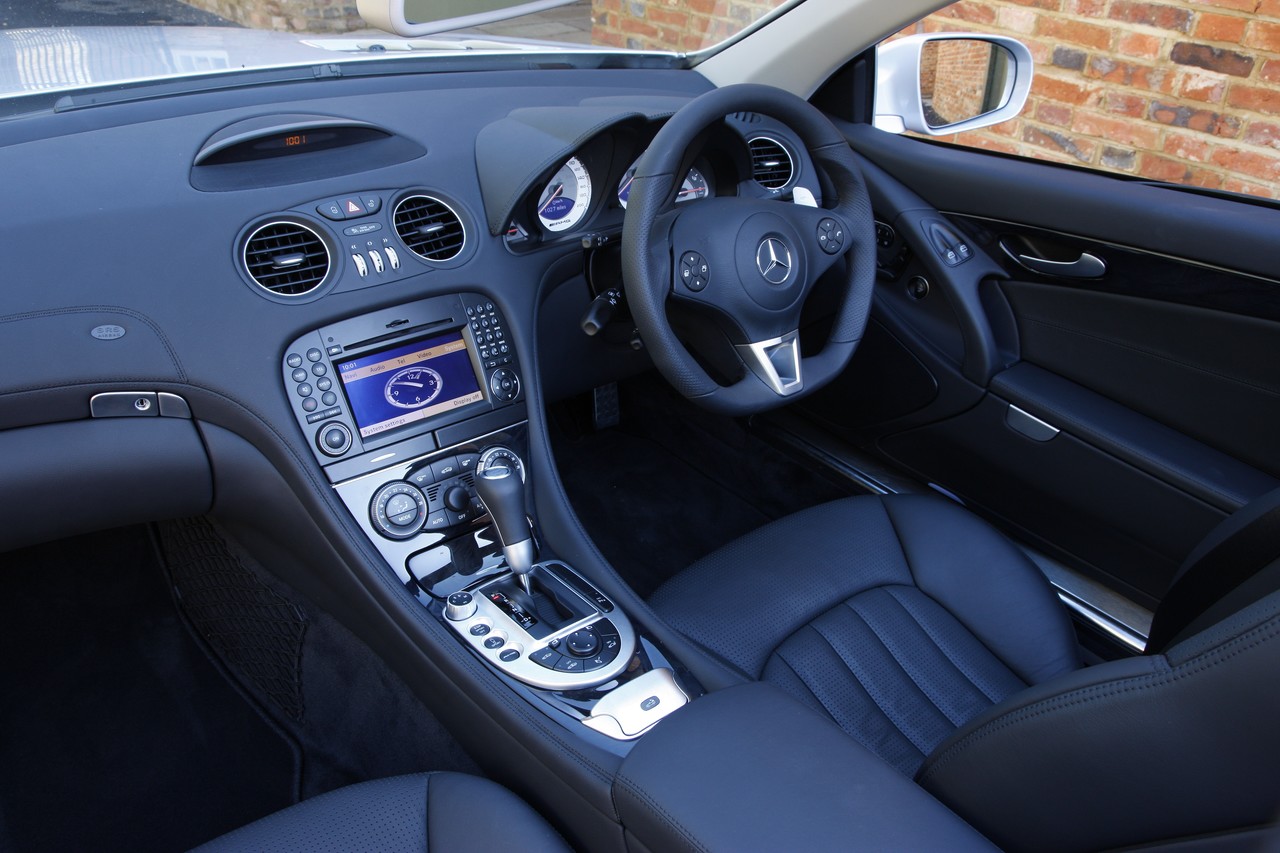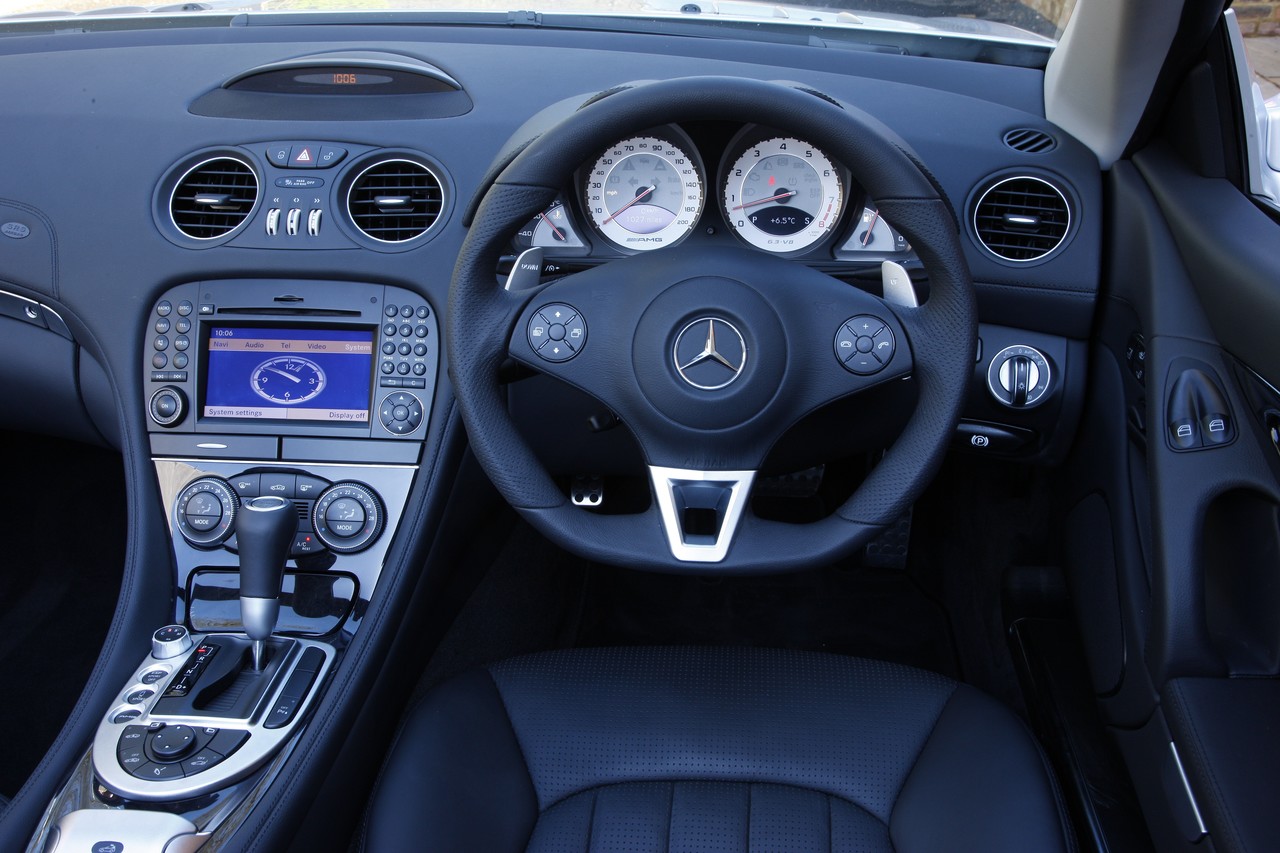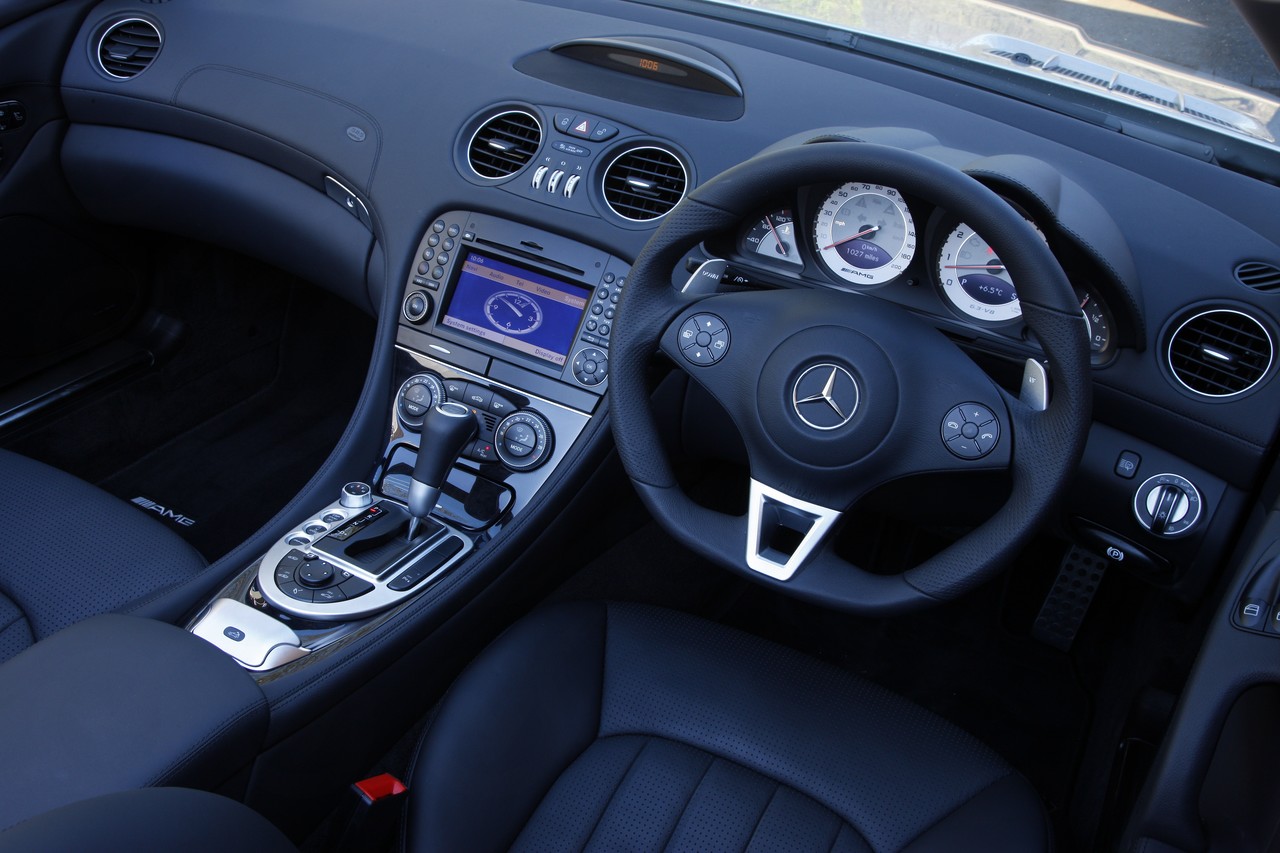
- Mass blunts agility
- For SL 65, good luck getting all that power to the ground
- M156 V8 engine susceptible to cylinder head bolt failure, camshaft lobe and valve lifter wear
- High running and maintenance costs
Review: Mercedes R230.I SL 55 and SL 65 AMG (2002-06)
Overview
Released in Australia in November 2002, the Mercedes-Benz R230 SL 55 AMG was a two-seat roadster with a retractable metal roof. Manufactured in Bremen, Germany, the rear-wheel drive R230 SL 55 AMG was powered by a supercharged 5.4-litre V8 petrol engine that was mated to a five-speed automatic transmission. Available in Australia from September 2004, the SL 65 AMG was powered by a 6.0-litre twin-turbo V12 petrol engine; it also had a five-speed automatic transmission.
SL 55 AMG: M113.992 V8 engine
The 5439 cc M113.992 V8 engine had a die-cast alloy block with 97.0 mm bores and a 92.0 mm stroke, cast-in Silitec cylinder liners, fracture-split forged steel connecting rods, iron-coated aluminium pistons with oil spray cooling, an alloy cylinder head, a single overhead camshaft (SOHC) per cylinder bank driven by a double-roller chain, three valves per cylinder (two intake, one exhaust) actuated by roller rockers, two-spark plugs per cylinder, a dual-length intake manifold, a compression ratio of 9.0:1 and Bosch ME 2.8 engine management.
The Lysholm-type IHI supercharger was positioned between the cylinder banks and had an integrated air-water charge air cooler. The supercharger had two Teflon-coated aluminium shafts which rotated at up to 23,000 rpm, pushing 1850 kg of air per hour into the combustion chambers – maximum charge pressure was 0.8 bar. To minimise fuel consumption at part throttle applications, the scroll compressor only operated at certain engine speeds and load conditions, activated by an electromagnetic coupling and a separate poly-V-belt.
Compared to its naturally aspirated counterpart, changes for the supercharged M113 engine included:
- A reinforced crankcase with stiffening ribs and side bolts;
- A precision-balanced crankshaft with modified bearings and a more resistant material;
- Unique pistons;
- Forged connecting rods;
- A revised oil supply system (including the sump, catch tray and pump) and a separate oil cooler in the right-hand wheel arch;
- Optimised cylinder heads;
- A twin-spring assembly for the valve train to increased maximum engine speed to 6100 rpm (from 5600 rpm);
- A redesigned fuel system;
- A twin-pipe exhaust system with switchover valve and 70 mm diameter tailpipes for reduced exhaust gas back-pressure; and,
- A unique engine management system.
The SL 55 AMG could accelerate from rest to 100 km/h in 4.7 seconds and had an electronically-limited top speed of 250 km/h. Over the combined EUDC cycle, fuel consumption was 14.2 litres per 100 km.
SL 65 AMG: Biturbo M275.981 V12 engine
The 5980 cc M275.980 V12 engine had a reinforced aluminium alloy block with 82.6 mm bores and a 93.00 mm stroke, an aluminium cylinder head, twin turbochargers, manifold injection, a single overhead camshaft per cylinder bank (SOHC), three valves per cylinder (two intake and one exhaust) that were actuated by aluminium roller rocker arms, two spark plugs per cylinder, and a compression ratio of 9.0:1. Furthermore, the twin turbochargers – one per cylinder bank – had air-to-liquid intercooler and provided peak boost pressure of 1.52 bar (22.1 psi).
Compared to the standard 6.0-litre biturbo V12, changes for the AMG version included:
- Higher-strength material for the crankshaft;
- Forged pistons were made from a temperature and pressure resistant material and had an upgraded oil-spray cooling system with a separate individual nozzle per piston. The size of the piston pins was also increased;
- The main and connecting rod bearings were made from higher-specification material;
- The combustion chambers in the cylinder heads were optimised;
- The camshafts had increased stroke on the intake side and longer opening times;
- The oil pump was modified and a larger oil cooler used to ensure lubrication under extreme conditions;
- The housings of the compressor and turbine, the turbine and the compressor wheels were enlarged;
- Maximum charge pressure was increased to 1.5 bar;
- Larger injection valve openings increased fuel throughput;
- New intercooler design which featured a 70 per cent larger front-mounted low-radiator;
- The system pressure of the computer-controlled fuel system was increased to 3.8 bar; and,
- A new engine management system was used, which included new wastegate valve actuation control for both turbochargers.
While the engine could produce peak torque of 1200 Nm, it was electronically-limited to 1000 Nm to protect the transmission.
The SL 65 AMG could accelerate from rest to 100 km/h in 4.2 seconds and to 200 km/h in 12.9 seconds, while its top speed was electronically-limited to 250 km/h. Over the combined EUDC cycle, fuel consumption was 15.1 litres per 100 km.
| Engine | Trans. | Years | Peak power | Peak torque | |
|---|---|---|---|---|---|
| SL 55 AMG | 5.4-litre s/charged petrol V8 (M113) | 5sp auto | 2002-06 | 368 kW at 6100 rpm | 700 Nm at 2750-4500 rpm |
| SL 65 AMG | 6.0-litre twin-turbo petrol V12 (M275) | 5sp auto | 2004-06 | 450 kW at 4800-5100 rpm | 1000 Nm at 2000-4000 rpm |
AMG Speedshift transmission (buttons)
The R230 SL 55 AMG and SL 65 AMG were fitted with the five-speed ‘AMG Speedshift’ automatic transmission which provided faster gearshifts than Mercedes-Benz’s conventional five-speed automatic transmission. Features of the AMG Speedshift transmission included:
- Steering wheel mounted gearshift buttons for sequential shifts;
- Had a torque converter lock-up function above first gear to reduce torque converter slip and increase fuel efficiency;
- Would automatically downshift if the required deceleration threshold was satisfied;
- Would stay in the current gear if a certain level of lateral acceleration was present (intended to delay or prevent gearshifts when cornering); and,
- An optimum gear function – selected by moving the ‘Touchshift’ lever to the left – which would cause the transmission to select the gear for maximum acceleration (depending on current speed and engine management data).
Gear ratios for the R230.I SL 55 AMG were 3.59 (1st), 2.19 (2nd), 1.41 (3rd), 1.00 (4th) and 0.83 (5th), while the final drive ratio was 2.82. For the SL 65 AMG, ratio changes were made to first gear (3.60) and the final drive ratio (2.65).
For the CL 65 AMG, changes for the AMG Speedshift transmission included:
- New converter discs with a metal coating;
- A larger torque-converter lock-up clutch; and,
- Modified shift and torque converter lock-up logic.
Dimensions
The SL 55 AMG was 4535 mm long, 1815 mm wide, 1295 mm tall and had a 2560 mm long wheelbase; the SL 65 AMG had the same dimensions, with the exception of height (1298 mm) due to its 19-inch alloy wheels although with lower profile tyres. While the SL 55 AMG had a kerb weight of 1955 kg, the SL 65 AMG was 155 kg heavier at 2110 kg.
The power-operated, three-piece ‘Vario Roof’ could be lowered or raised in 16 seconds. Cargo capacity was 317 litres when the roof was raised, though this decreased to 235 litres when it was lowered.
Suspension and Active Body Control (ABC)
The Mercedes-Benz SL 55 AMG and SL 65 AMG had four-link front suspension and independent five-link rear suspension, the latter made from aluminium to reduce mass. Relative to the R230 SL-Class , changes to the rear axle of the SL 55 AMG included reinforced wheel location components, steel sub-frame and spring links. For the SL 65 AMG, suspension changes included:
- Special AMG spring struts with firmer damping;
- Special drive shafts;
- Larger hub carriers and wheel bearings; and,
- Special rear spring links.
As standard, the suspension of the SL 55 AMG and SL 65 AMG included Mercedes-Benz’s ‘Active Body Control’ (ABC) which used hydraulically controlled servo cylinders – known as plunger pistons – in the suspension struts. The servo cylinders consisted of a moving capsule which the coil spring used for vertical support. When driving, hydraulics would activate the plunger to exert additional force, thereby modifying the effect of the coil springs. As the vehicle experienced body pitch, roll or lift, the movement of the spring plate would alter the tension in the coil spring, counteracting body movement. Signals from sensors – which recorded the current level of the car above the ground and its acceleration – determined the magnitude of pressure that should be applied on the springs and its duration. With ABC, the driver could also select from ‘Comfort’ or ‘Sport’ drive modes.
The SL 55 AMG and SL 65 AMG were fitted with Mercedes-Benz’s ‘Active Body Control’ system which utilised hydraulic servo cylinders in the suspension struts, sensors and microprocessors to provide an adaptive suspension system which minimised pitch and body roll; the system also included selectable ‘Comfort’ and ‘Sport’ driving modes.
Steering
The Mercedes SL 55 AMG and SL 65 AMG had rack-and-pinion steering with speed-sensitive power assistance (Mercedes-Benz’s ‘parameter steering’).
Safety equipment
Standard safety equipment for the Mercedes SL 55 AMG and SL 65 AMG included dual front airbags (with two-stage deployment), front door-mounted side airbags with head and thorax protection, ABS, electronic brake force distribution, brake assist, electronic stability control, traction control, automatically deploying roll-over bars and front seatbelts with pre-tensioners and load limiters.
The SL 55 and SL 65 AMG were fitted with Sensotronic Brake Control (SBC). By monitoring throttle release and brake pedal pressure, SBC could detect emergency braking operations and react by increasing pressure in the brake connectors to increase braking force. Other functions of SBC included:
- When cornering, SBC could apply greater braking force to the outer wheels to increase lateral forces to maintain the vehicle’s path and provide more stable braking; and,
- When the windscreen wipers had been operating (i.e. wet weather), SBC would apply short brake impulses to remove the film of water on the brake discs (automatic brake drying).
Brakes: SL 55 and SL 65 AMG
The SL 55 AMG had 360 mm front brake discs with eight-piston callipers and 330 mm rear discs with four-piston callipers; both front and rear discs were internally vented and perforated. The SL 65 AMG, however, had 390 mm by 36 mm composite front brake discs with six-piston callipers and 360 mm by 26 mm rear discs with four-piston callipers.
Features: Mercedes SL 55 AMG
Standard features for the Mercedes SL 55 AMG included 18-inch multi-spoke AMG alloy wheels (8.5J front and 9.5J rear) with 255/40 R18 95Y front tyres and 285/35 R18 97Y rear tyres, an eight speaker ‘Audio 30’ sound system with a ten-disc CD changer, COMAND (Cockpit Management and Data System) with satellite navigation, dual-zone climate control air conditioning, leather upholstery, multi-contour front seats with power adjustment, ventilated and heated front seats, cruise control (‘Speedtronic’), bi-xenon headlights, front fog lamps, automatic headlights, rain-sensing wipers, front and rear parking sensors, a cooled glovebox, leather-wrapped steering wheel and gear shift, remote central locking, power windows and mirrors, automatically dipping door mirrors on reverse, a power adjustable steering column (for height and reach), memory settings (front seats, mirrors and steering column), tinted windows, an anti-glare review mirror, Alcantara cover for the instrument cluster, tinted glass, a wind deflector, trip computer, an alarm and immobiliser.
Features: Mercedes SL 65 AMG
Compared to the SL 55 AMG, the Mercedes SL 65 AMG was further equipped with 19-inch twin-spoke AMG alloy wheels (8.5J front and 9.5J rear) with 255/35 ZR 19 96Y front and 285/30 ZR 19 97Y rear tyres, Nappa leather upholstery, tyre pressure monitoring and an alarm with motion and tow-away sensors. The SL 65 AMG was also fitted with a mechanical, asymmetric, multi-disc limited slip differential which had a lock factor of 40 per cent under load.
Brochure
Review: Mercedes R230.II SL 55 and SL 65 AMG (2006-08)
Overview
Released in April 2006, the Mercedes R230 Series II (R230.II) SL 55 AMG and SL 65 AMG introduced cosmetic updates, an AMG Speedshift transmission with steering wheel gearshift paddles, re-engineered suspension and revised steering; the engine for the SL 55 AMG was also upgraded.
Visually, the R230.I SL 55 AMG and SL 65 AMG could be identified by their new front aprons which had a more pronounced wedge shape, chrome-ringed fog lamps, AMG radiator grille with three black louvres and new tail-lights. Inside, there new carbon-fibre trim elements, an AMG steering wheel with gearshift paddles, AMG main menu in the instrument cluster with ‘Racetimer’ function for recording lap times on racing circuits, metal door sill panels with ‘AMG’ lettering, new-look instrument cluster shroud trimmed in nappa leather and a new digital clock.
SL 55 AMG: M113.992 V8 engine
The R230.II SL 55 AMG was powered by Mercedes-Benz’s M113.992 supercharged V8 engine which had a new, higher-speed supercharger compressor and a larger throttle valve. Furthermore, the engine management system introduced cylinder-selective pilot control of the firing angle which would set the optimum combustion point individually for each cylinder.
The R230.II SL 55 AMG could accelerate from rest to 100 km/h in 4.5 seconds, 0.2 seconds faster than the R230.I SL 55 AMG. Over the combined EUDC test cycle, fuel consumption was 13.5 litres per 100 km.
AMG Speedshift (paddles)
For the R230.II SL 55 and SL 65 AMG, the five-speed AMG Speedshift automatic transmission provided fully automated gearshifts or, in manual ‘M’ mode, enabled the driver to perform gearshifts via steering wheel paddles. In the manual ‘M’ mode, the transmission would not automatically shift up when the rev limit was reached and would only shift down when engine speed approached the lower limit of the rev band. Other features of the AMG Speedshift transmission included:
- A torque converter lock-up function above first gear to reduce torque converter slip and increase fuel efficiency;
- Would stay in the current gear if a certain level of lateral acceleration was present (intended to delay or prevent gearshifts when cornering);
- An optimum gear function – selected by moving the ‘Touchshift’ lever to the left – which would cause the transmission to select the gear for maximum acceleration (depending on current speed and engine management data); and,
- Active engine-braking downshifts.
Compared to its predecessor, this AMG Speedshift had a new torque converter that was adapted to handle the increased torque of the supercharged V8 engine.
| Engine | Trans. | Peak power | Peak torque | |
|---|---|---|---|---|
| SL 55 AMG | 5.4-litre s/charged petrol V8 (M113) | 5sp auto | 380 kW at 6100 rpm | 720 Nm at 2600-4000 rpm |
| SL 65 AMG | 6.0-litre twin-turbo petrol V12 (M275) | 5sp auto | 450 kW at 4800-5100 rpm | 1000 Nm at 2000-4000 rpm |
Suspension
The sports suspension for the R230.II SL 55 AMG and SL 65 AMG was based on Mercedes-Benz’s second-generation Active Body Control (ABC) and, combined with revised front axle elastokinematics, designed to provide a sportier drive. A new function for ABC was ‘variable roll moment distribution’ which made adjustments for the front and rear axles according to vehicle speed.
Steering
For the R230.II SL 55 AMG and SL 65 AMG, changes included a new power steering pump, new steering pump, modified valve control logic for faster response when centred and a steering ratio that was 7 per cent more direct.
Brakes
The R230.II SL 55 AMG was fitted with 360 mm by 36 mm composite front brake discs with six-piston callipers and 330 mm by 26 mm rear discs with four-piston callipers; both front and rear discs were internally ventilated and perforated.
The braking system for the SL 65 AMG, however, was unchanged.
Features
Standard features for the Mercedes R230.II SL 55 AMG and SL 65 AMG were extended to include a Bose sound system, a TV tuner, tyre pressure monitoring and a motion-sensing alarm (the latter previously limited to the SL 65 AMG). The SL 65 AMG was further equipped with Mercedes-Benz’s ‘Linguatronic’ voice recognition system for the audio, telephone and navigation systems.
As standard, the SL 55 AMG and SL 65 AMG were also fitted with a removable luggage cover which increased boot capacity by 22 litres to 339 litres.
August 2007
From August 2007, the SL 55 AMG was equipped with Linguatronic; the SL 65 AMG also featured ‘Exclusive’ nappa leather upholstery.
Review: Mercedes R230.III SL 63 and SL 65 AMG (2008-12)
Overview
Released in June 2008, the Mercedes-Benz R230 Series III (R230.III) SL range consisted of the SL 63 AMG and SL 65 AMG, with the former replacing the SL 55 AMG. Visually, the R230.III SL 63 and SL 65 AMG could be identified by their new front aprons with larger air intakes, black radiator grilles and new door mirrors with arrow-shaped LED indicators.
Inside, the SL 63 AMG and SL 65 AMG had a new three spoke AMG steering wheel with perforated leather grip areas, while the introduction of Mercedes-Benz’s NTG 2.5 telematics system was accompanied by a 6.5-inch, high-resolution colour display for COMAND APS and a keypad for entering telephone numbers and radio frequencies.
SL 63 AMG: M156 engine
Developed and hand-assembled by Mercedes-AMG in Affalterbach, Germany, the 6208 cc M156 V8 petrol engine had an aluminium-silicon alloy (AlSi7) block which had 102.2 mm bores and a 94.6 mm stroke, an aluminium-silicon alloy (AlSi17) cylinder head, a Cromax 42CrMo4V forged steel alloy crankshaft with six counterweights rotating on five bearins, fracture-split forged connecting rods, cylinder bores with twin-wire-arc-sprayed (TWAS) coating, Bosch 9.7 engine management system, double overhead camshafts per cylinder bank (intake cams driven by a double chain from the crankshaft and small gears on the intake cams drive the exhaust camshafts), continuously variable intake and exhaust camshafts (over a range of 42 degrees via electrohydraulic vane-type adjusters), four valves per cylinder (40 mm intake valves and 34 mm exhaust valves), bucket tappets, a magnesium variable intake manifold (with two electrically-operated internal flaps) and a compression ratio of 11.3:1. Maximum engine speed was 7200 rpm.
The SL 63 AMG could accelerate from rest to 100 km/h in 4.6 seconds; over the combined ADR 81/02 test cycle, fuel consumption was 13.9 litres per 100 km. Relative to the SL S65 AMG, the SL 63 AMG was 150 lighter with a kerb weight of 1970 kg.
SL 63 AMG: AMG Speedshift MCT
Produced at the Mercedes-Benz Esslingen-Hedelfingen plant, the seven-speed ‘AMG Speedshift MCT’ (Multi Clutch Technology) had a compact, wet start-up clutch that operated in an oil bath rather than a conventional torque converter. The AMG Speedshift transmission had four individual driving modes which the driver could select via a rotary dial:
- Controlled Efficiency, ‘C’, for softer throttle response, smooth gearshifts and early upshifts to minimise fuel consumption;
- Sport, ‘S’, for greater throttle response, higher engine speeds before upshifting, greater willingness to downshift and 20 per cent faster gearshifts;
- Sport plus, ‘S+’, for 20 per cent faster gearshifts relative to Sport; and,
- Manual, ‘M’, for maximum throttle response and gearshifts 10 per cent faster than Sport plus (as quickly as 100 milliseconds). For fast gearshifts under full loads, the engine could partially suppress individual cylinders by interrupting ignition and injection.
Other features of the AMG Speedshift transmission included:
- Automatic throttle-blipping on downshifts;
- A double-declutching function for multiple downshifts in Sport, Sport plus and Manual modes; and,
- A ‘Race Start’ function.
The gear ratios for the ‘AMG Speedshift’ transmission were 4.38 (1st), 2.86 (2nd), 1.92 (3rd), 1.37 (4th), 1.00 (5th), 0.82 (6th) and 0.73 (7th), while the final drive ratio was 3.06. Furthermore, the transmission had a torque capacity of 735 Nm.
| Engine | Trans. | Years | Peak power | Peak torque | |
|---|---|---|---|---|---|
| SL 63 AMG | 6.2-litre petrol V8 (M156) | 7sp semi-auto | 2008-12 | 386 kW at 6800 rpm | 630 Nm at 5250 rpm |
| SL 65 AMG | 6.0-litre twin-turbo petrol V12 (M275) | 5sp auto | 2008-12 | 450 kW at 4800-5100 rpm | 1000 Nm at 2000-4000 rpm |
| SL 65 AMG Black Series | 6.0-litre twin-turbo petrol V12 (M275) | 5sp auto | 2009 | 493 kW at 5400 rpm | 1000 Nm at 2200-4200 rpm |
Brakes: SL 63 AMG
The R230.III SL 63 AMG had 360 mm by 36 mm composite front brake discs with six-piston fixed aluminium callipers and 330 mm by 26 mm discs with four-piston fixed callipers.
Features: SL 63 AMG and SL 65 AMG
Unlike the SL 55 AMG, the SL 63 AMG had the same wheel and tyre dimensions as the SL 65 AMG, consisting of 19-inch AMG alloy wheels (8.5J front and 9.5J rear) with 255/35 R19 front and 285/30 R19 rear tyres.
Compared to their R230.II predecessors, standard features for the R230.III SL 63 AMG and SL 65 AMG were extended to include a ten speaker Harman Kardon Logic7 surround sound system with MP3-compatibility, auxiliary inputs (3.5 mm/USB/SD card), hard drive audio storage and speed-sensitive volume control, directional bi-xenon headlights and ‘Airscarf’ neck-level heating.
For the R230.III SL 65 AMG, its limited slip differential which provided a lock factor of up to 30 per cent rather than 40 per cent as per its R230.II predecessor.
Mercedes R230 SL 65 AMG Black Series
IIn 2009, ten (10) SL 65 AMG Black Series were delivered to Australia. Compared to the SL 65 AMG, the Black Series engine produced peak power of 493 kW due to its:
- new turbochargers with twelve per cent larger spiral cross sections;
- optimised wastegate ducts;
- 30 per cent more effective charge air cooler; and,
- AMG exhaust for reduced back pressure.
The AMG Speedshift transmission was also modified as the Sport plus and manual modes were replaced by M1 and M2 modes, the latter providing gearshifts 25 per cent faster than M1. As a result of these changes, the SL 65 AMG Black Series could accelerate from rest to 100 km/h in 3.8 seconds and to 200 km/h in 11.0 seconds; top speed was electronically limited to 320 km/h.
The SL 65 AMG Black Series was 250 kg lighter than the standard SL 65 AMG; changes included:
- Replacement of the retractable hardtop roof with a fixed carbon fibre reinforced plastic (CFRP) roof which had an integral roll-over bar;
- CFRP for the 140 mm wider front mudguards, front apron, front splitter, bonnet, bootlid, rear diffuser and retractable rear spoiler (which automatically extended 120 mm at 120 km/h to reduce rear axle lift);
- Weight-optimised twin-spoke AMG forged alloy wheels. As such, the SL 65 AMG Black Series had 19 x 9.5J front wheels with 265/35 R19 front Dunlop Sport Maxx GT tyres and 20 x 11.5J rear wheels with 325/30 R20 tyres; and,
- Weight-optimised aluminium wheel carriers.
The suspension for the SL 65 AMG Black included adjustable coil spring lines to allow adjustment of the shock absorbers’ rebound and compression stages, ride height, wheel alig Nment and camber. Other suspension changes included:
- 97 mm wider front and 85 mm wider rear track widths (relative to the SL 65 AMG);
- New spring link, camber struts and pull/push rods; and,
- New front axle kinematics which resulted in an 8 per cent more direct steering ratio.
The SL 65 AMG Black Series was also fitted with a multi-disc limited slip differential which had a 40 per cent locking effect.
Brochure
- Brochure: Mercedes R230.III SL 63 and SL 65 AMG (International) (January 2008)
- Brochure: Mercedes R230.III SL 65 AMG Black (June 2008)
- Brochure: Mercedes-Benz R230.III SL-Class (April 2011)
Related links
